Dialects of English Dr. C. George Boeree

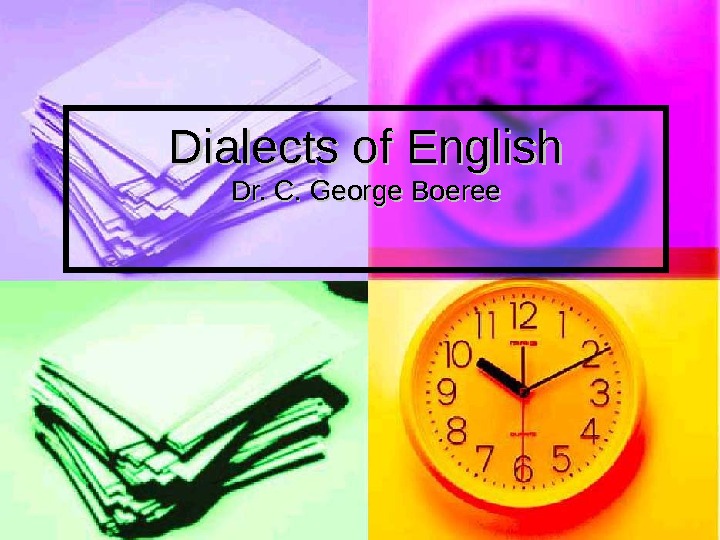
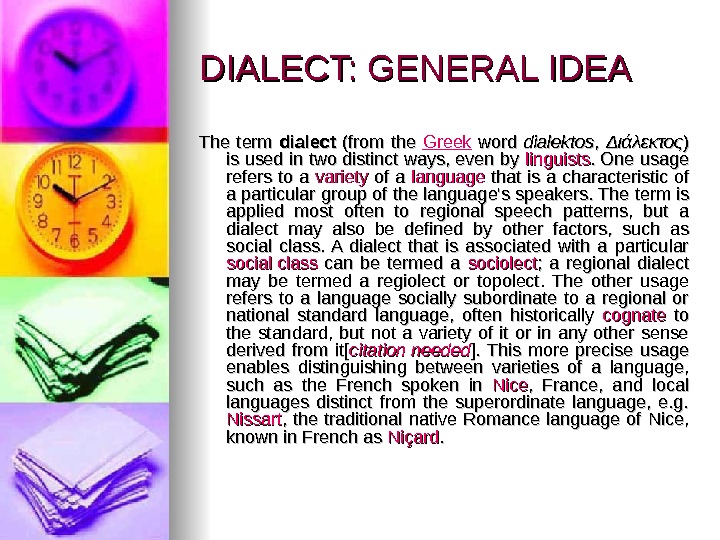
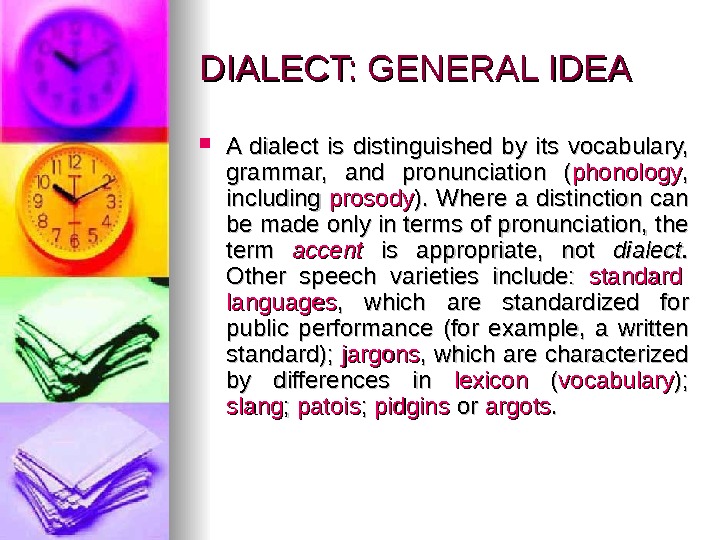
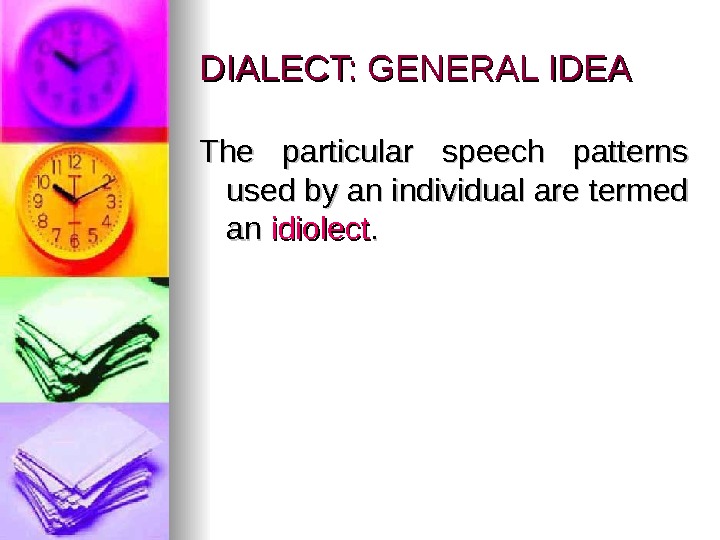

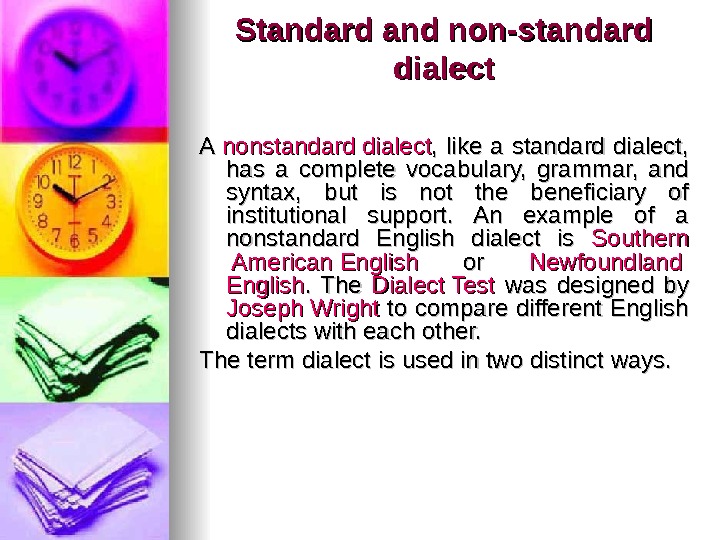
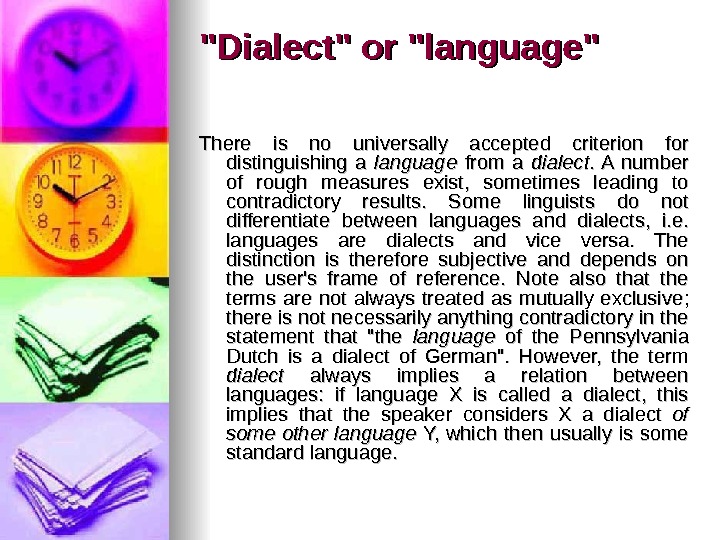
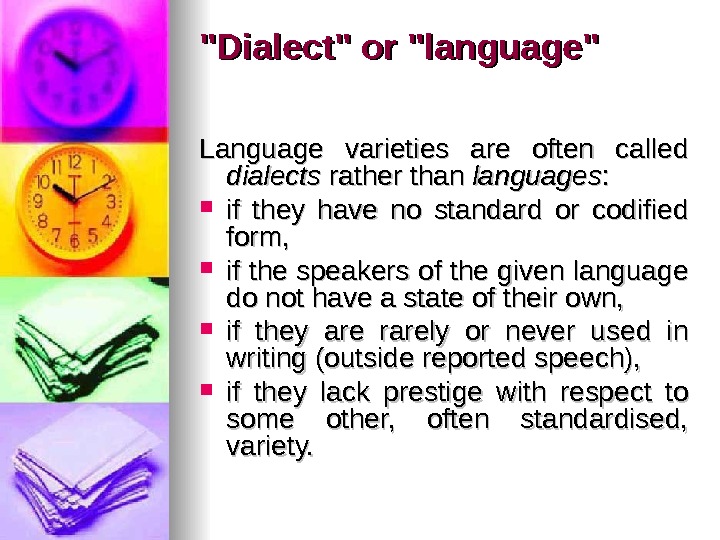
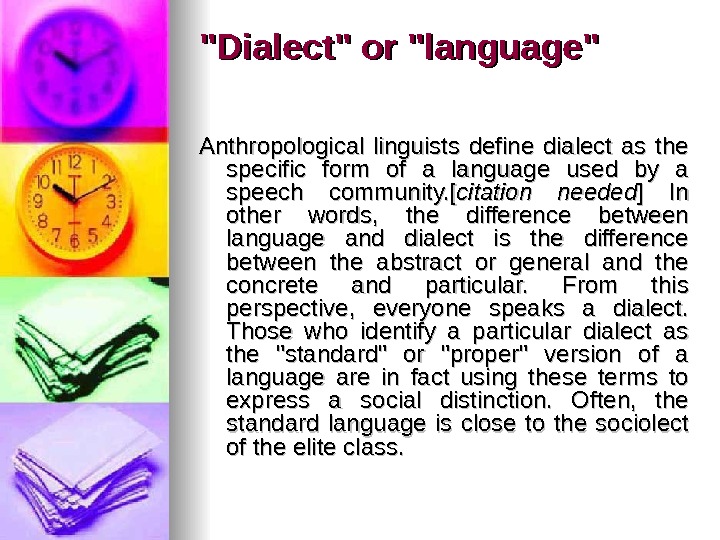
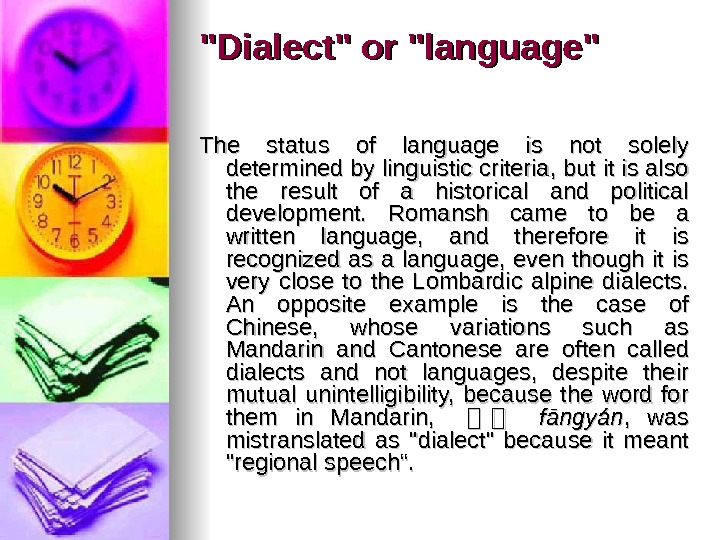
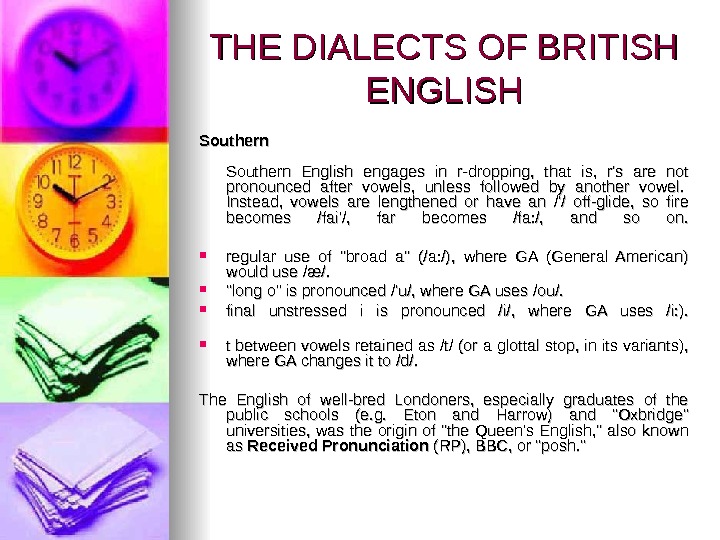
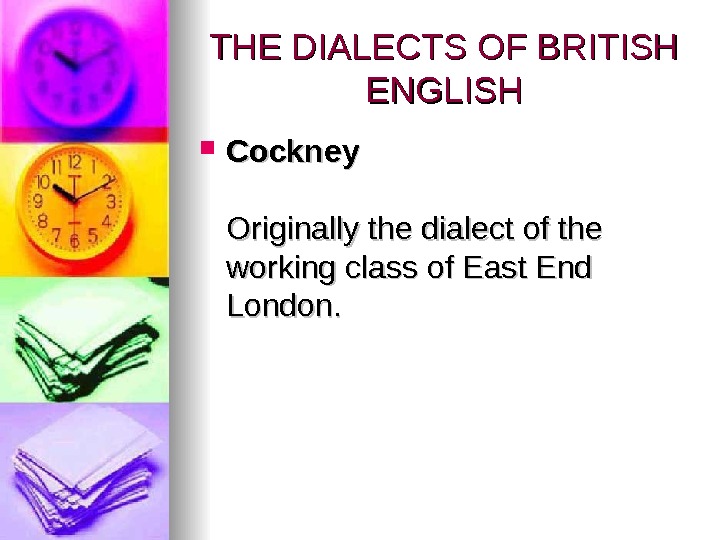
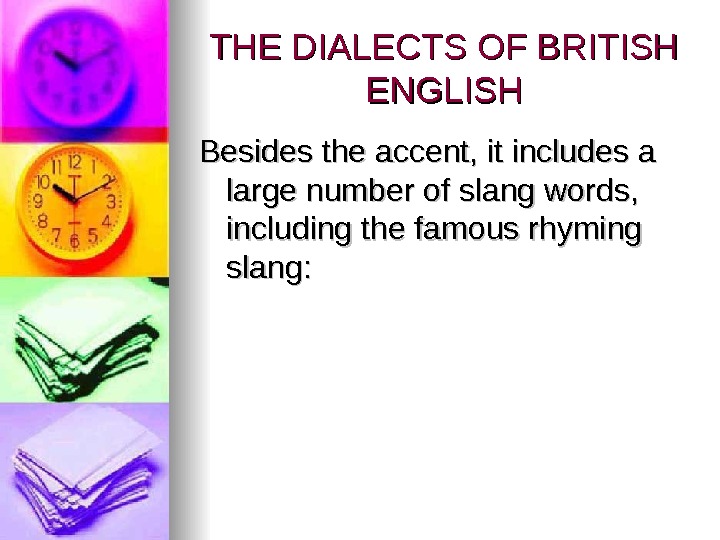
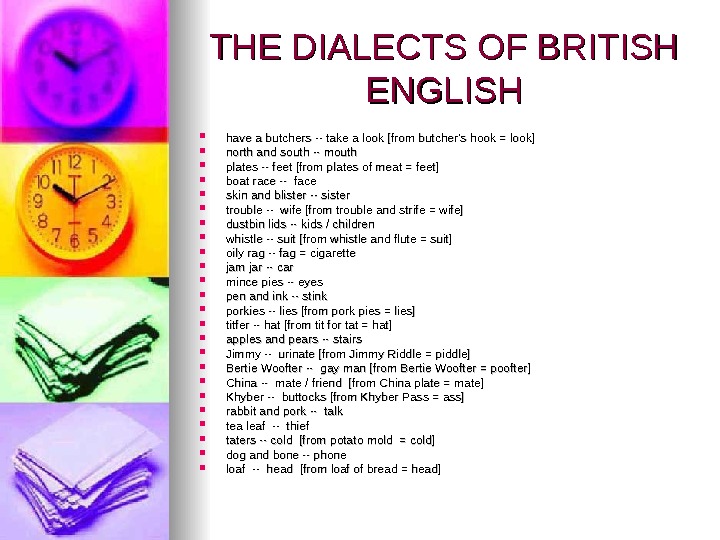

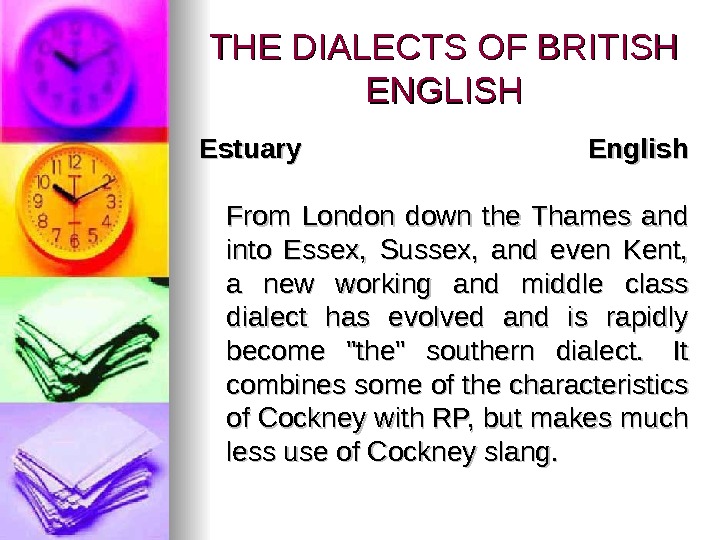
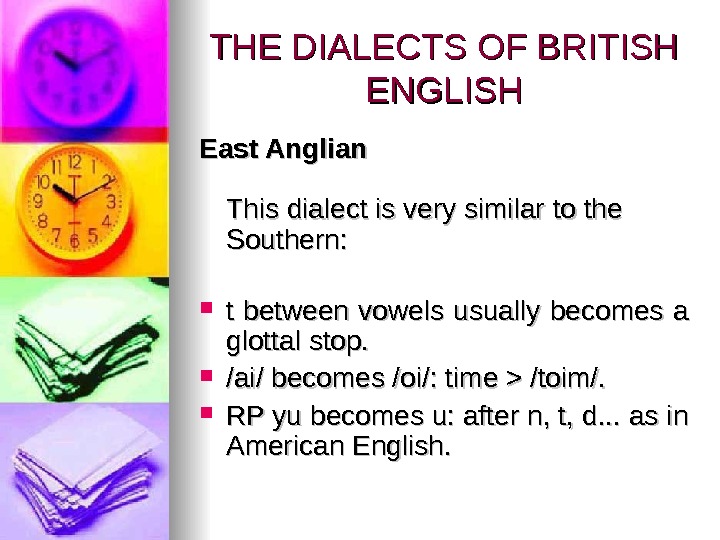

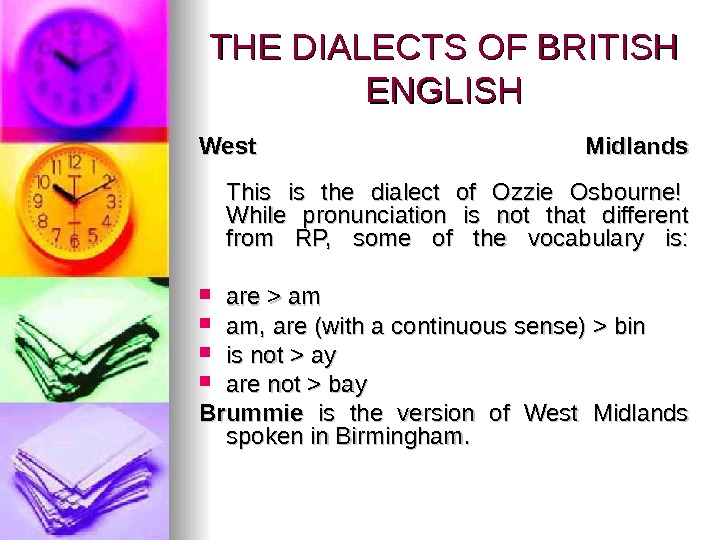
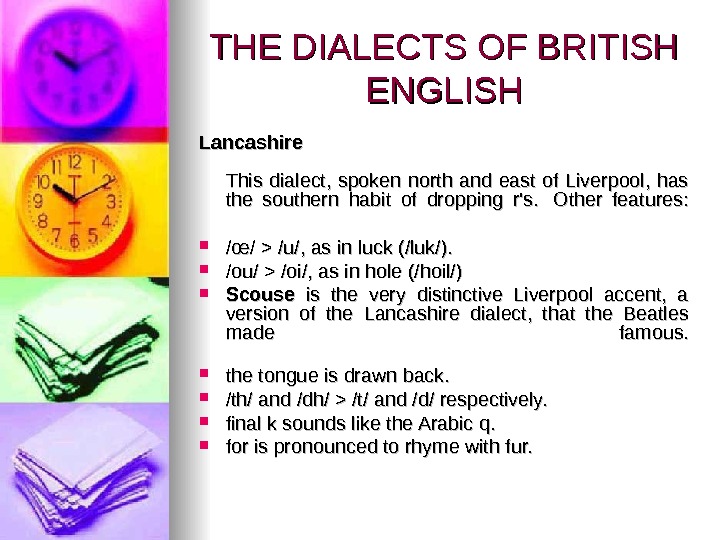
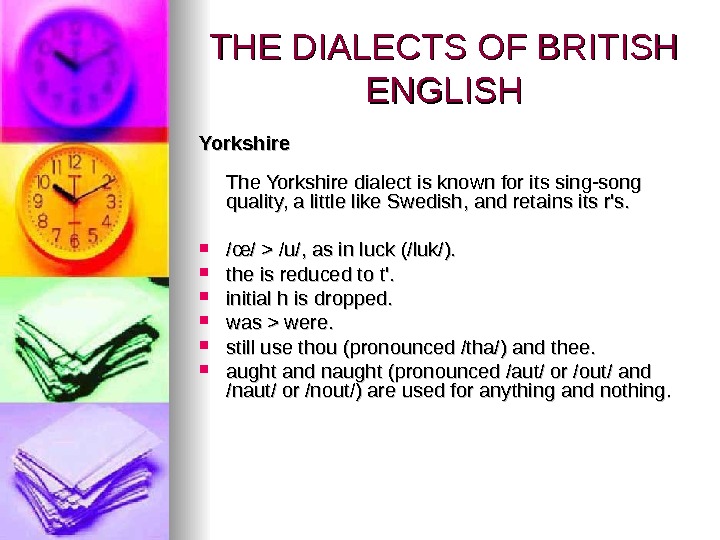
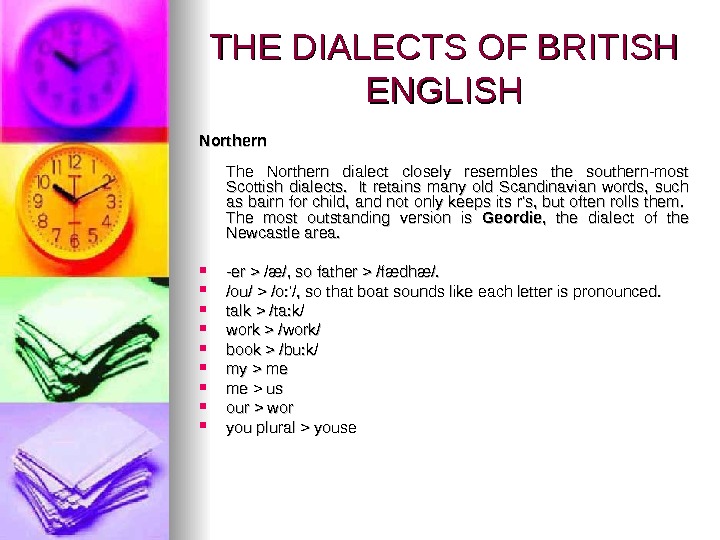
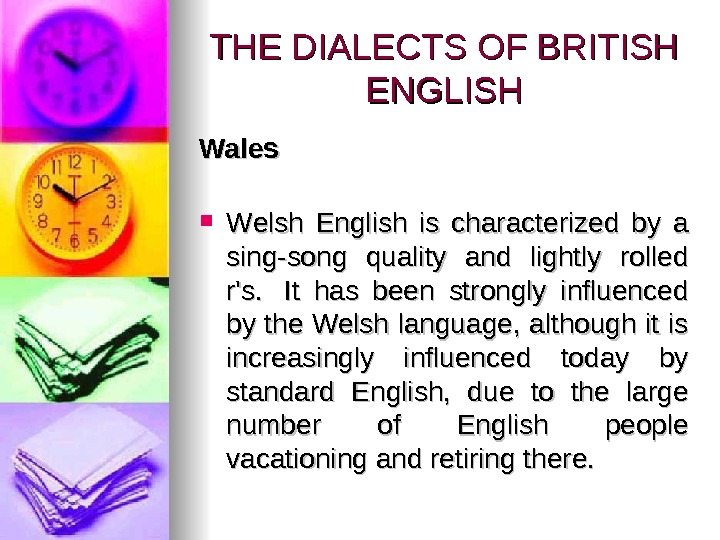
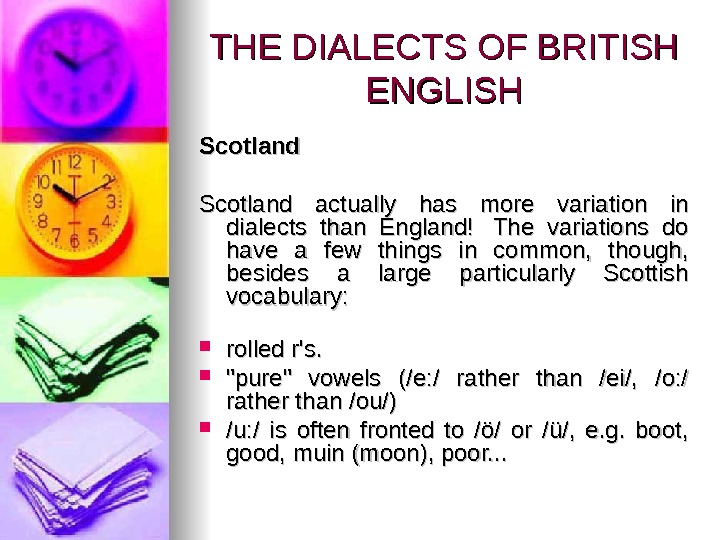
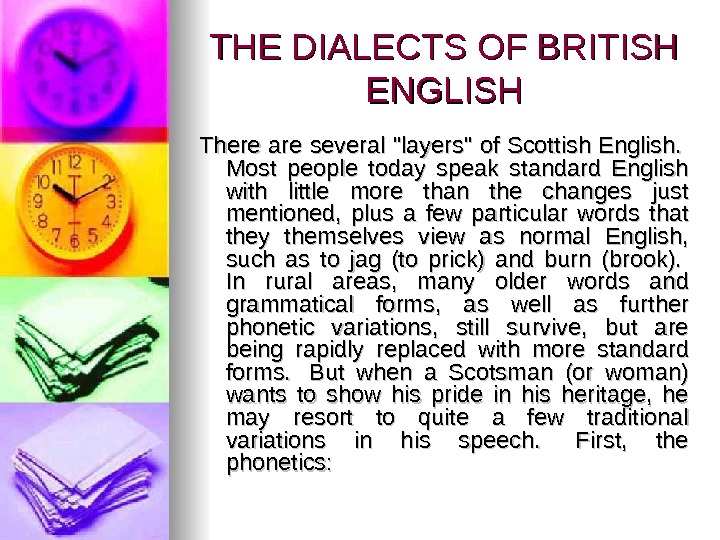
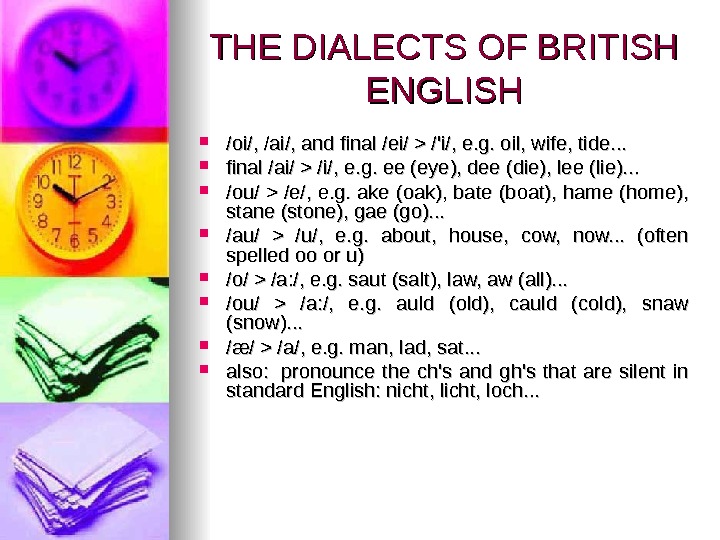
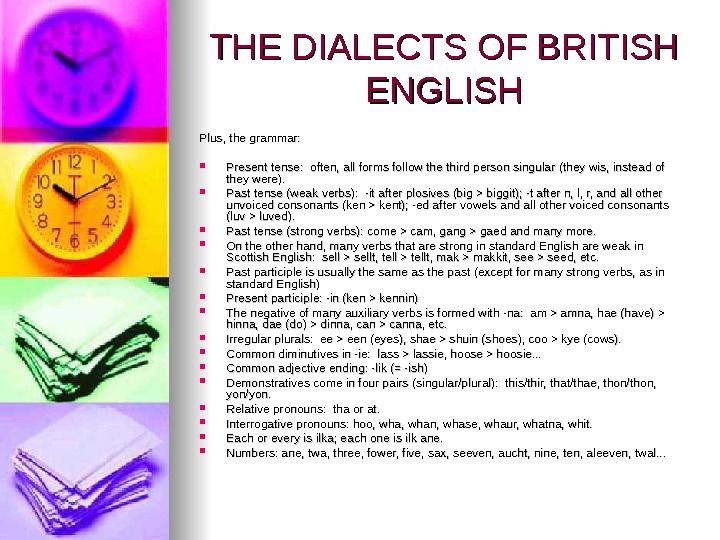
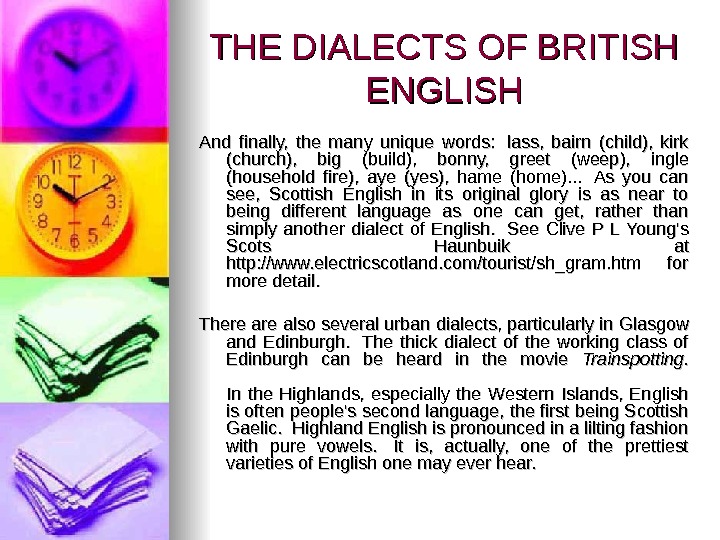
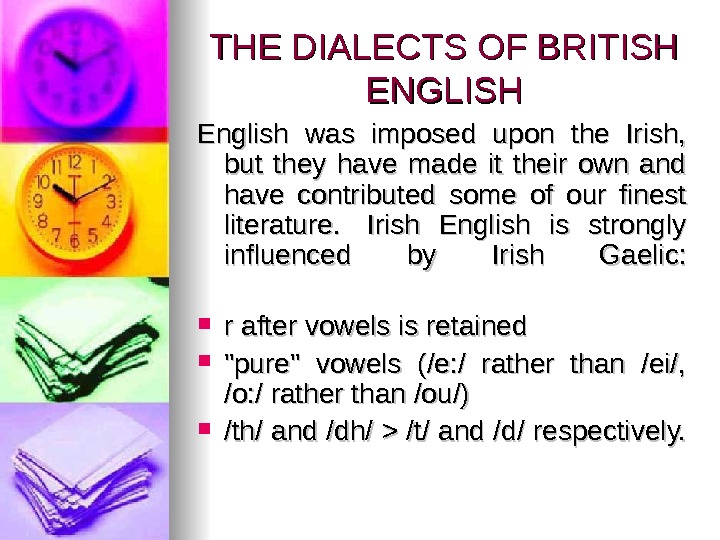
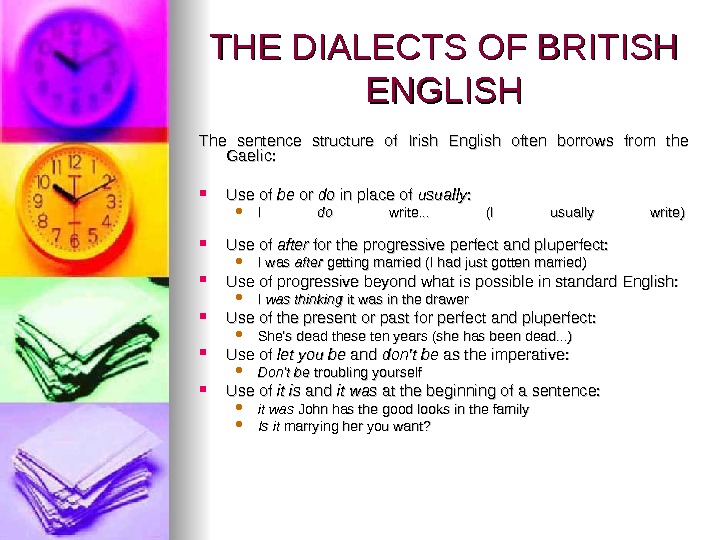
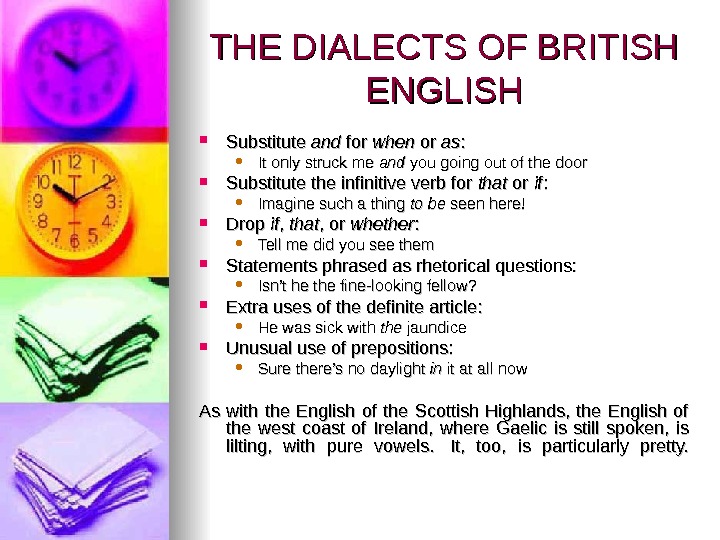
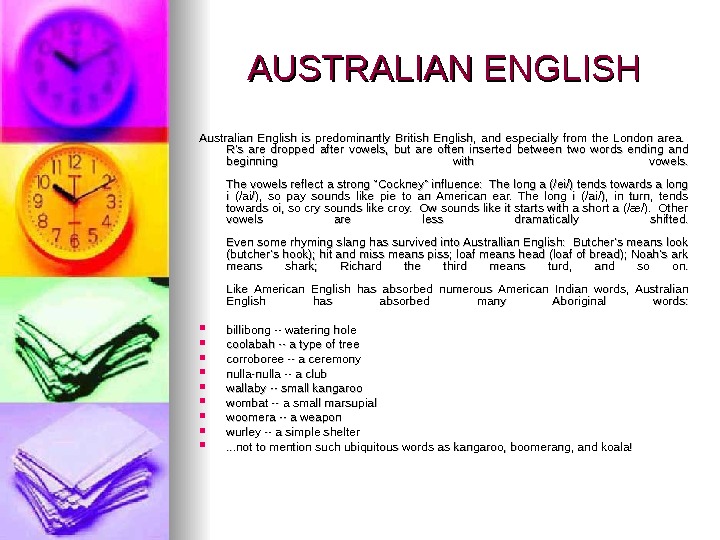
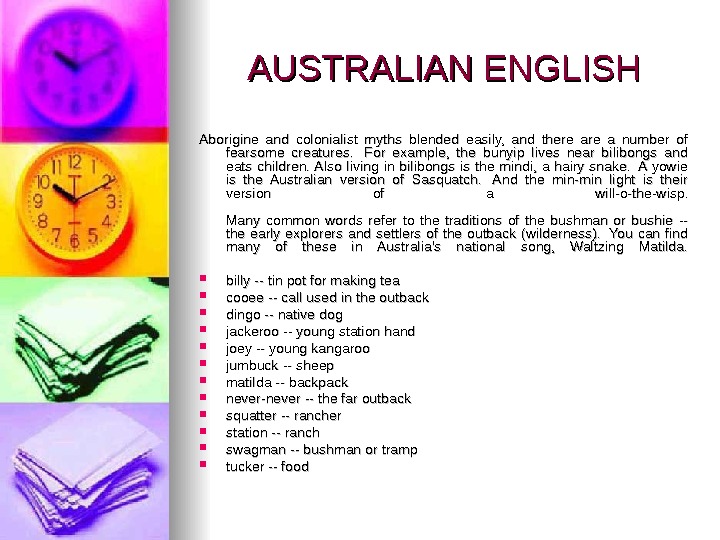
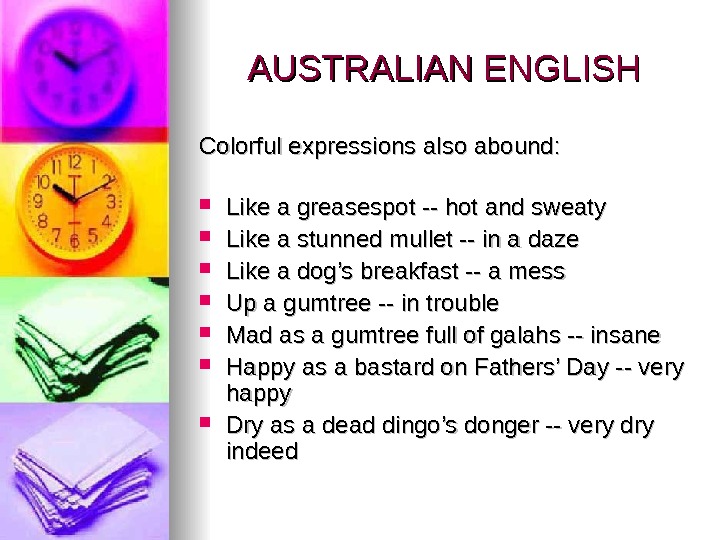
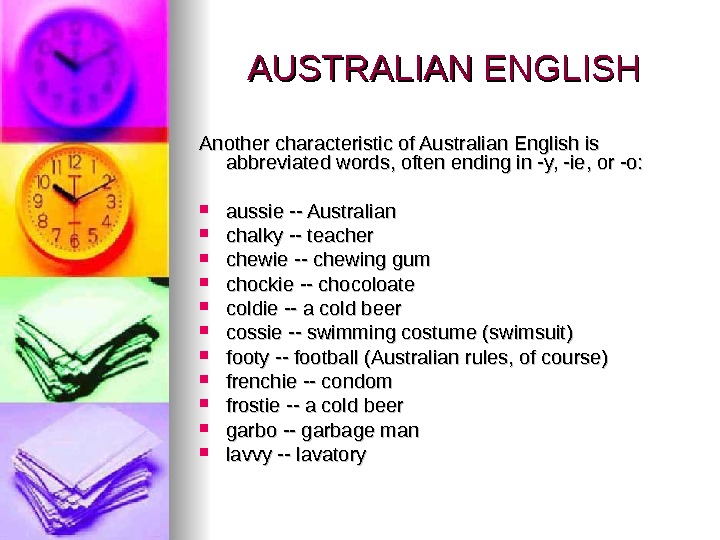
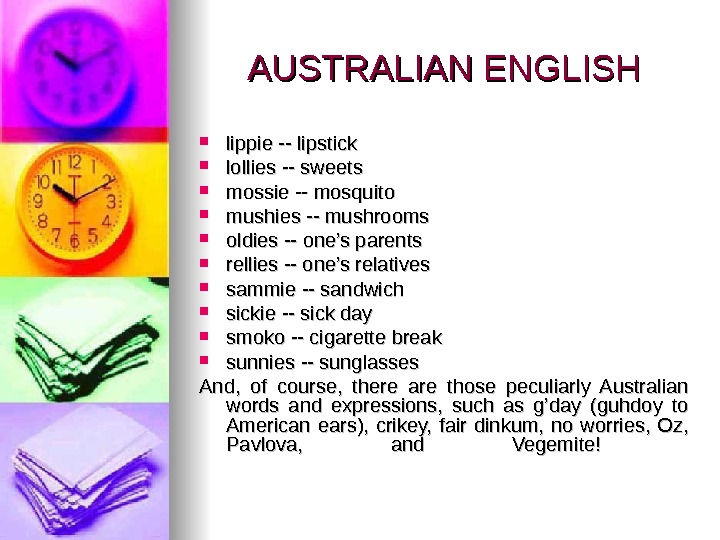
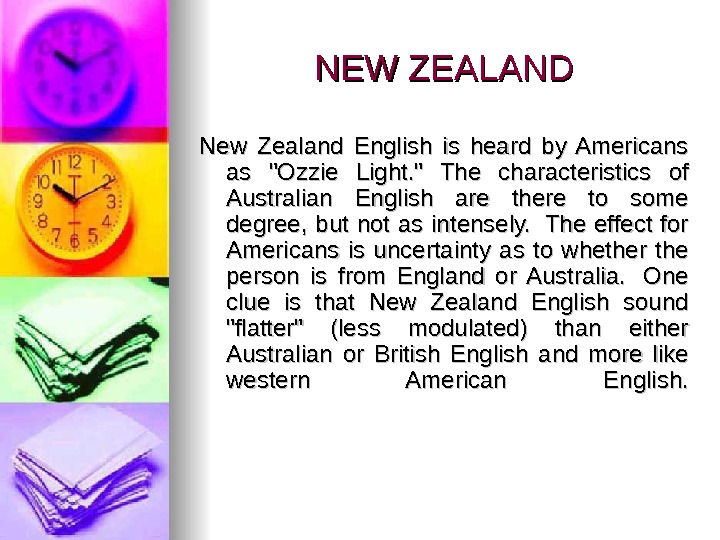

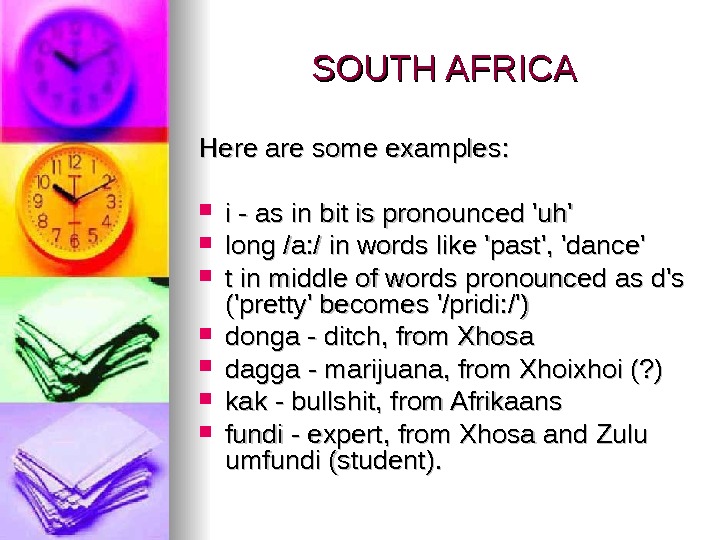
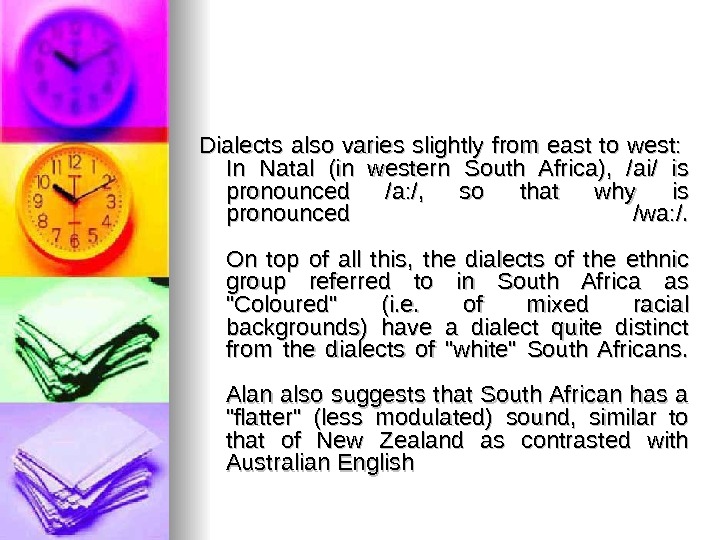
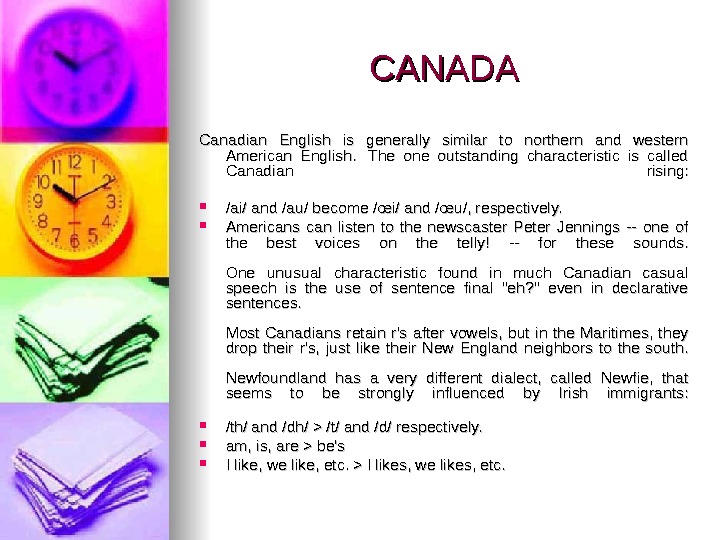
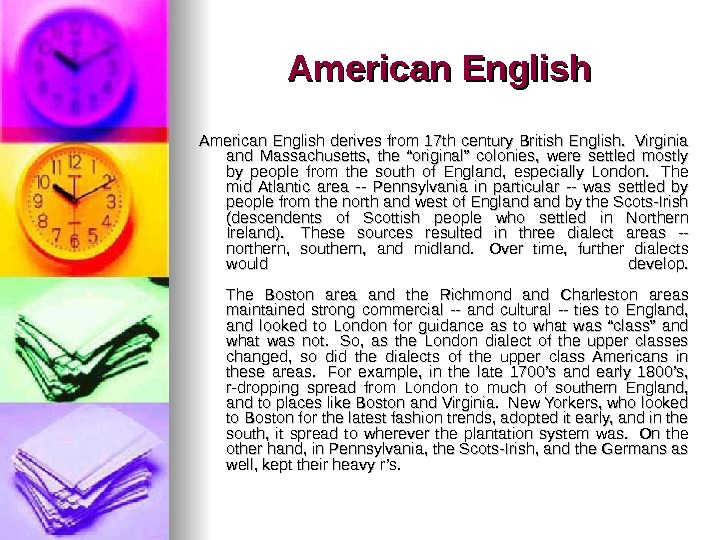
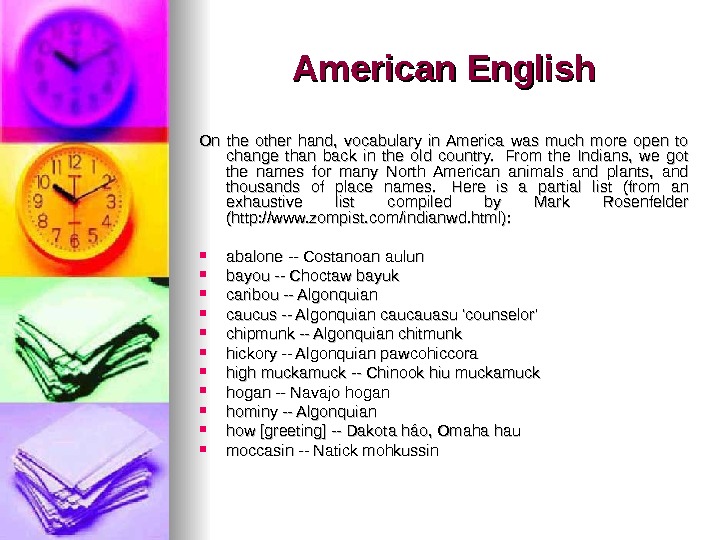
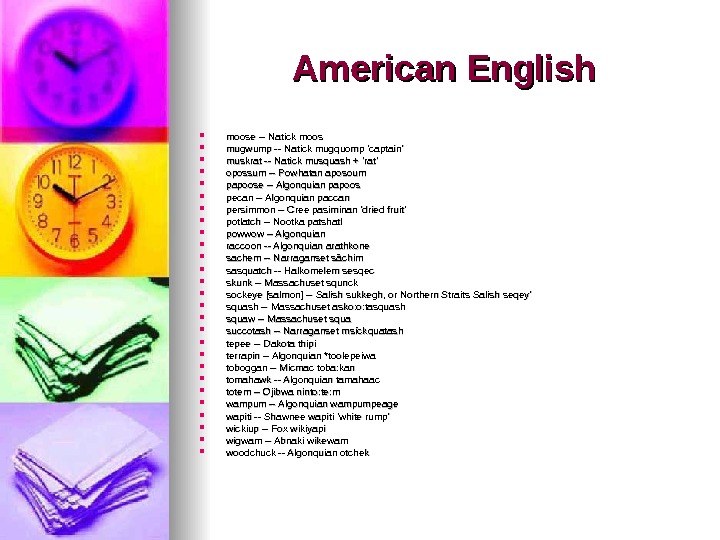
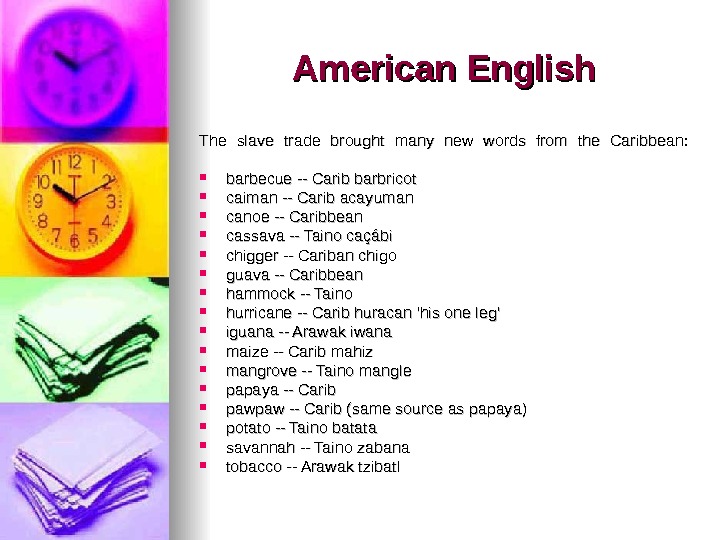
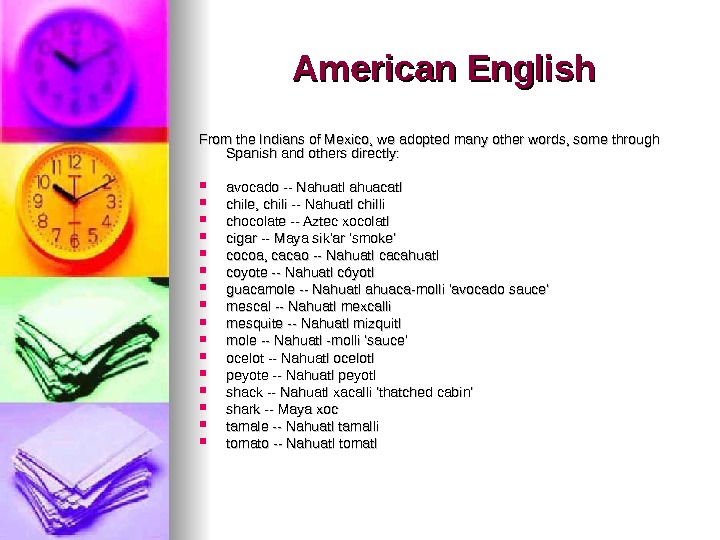
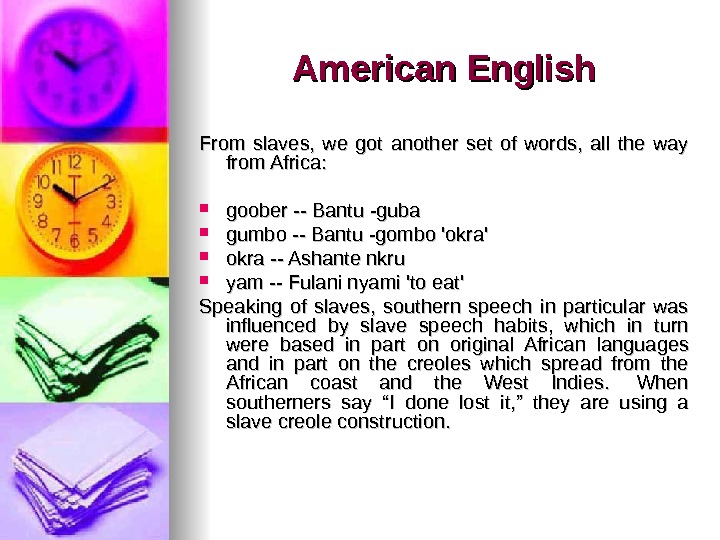
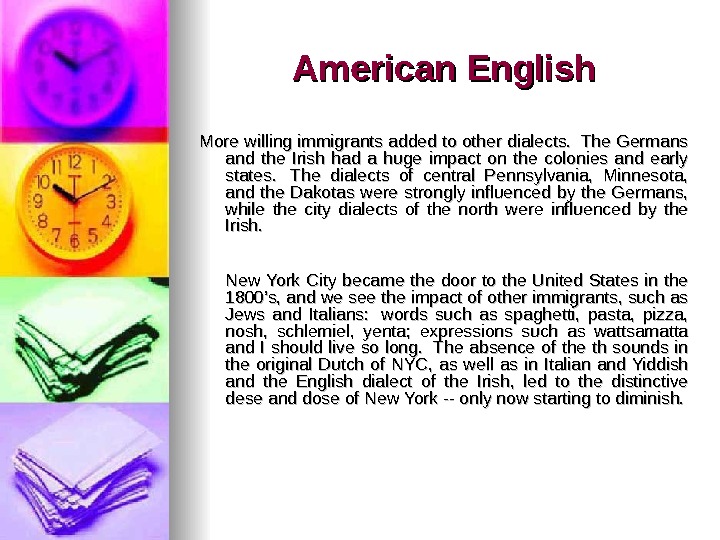

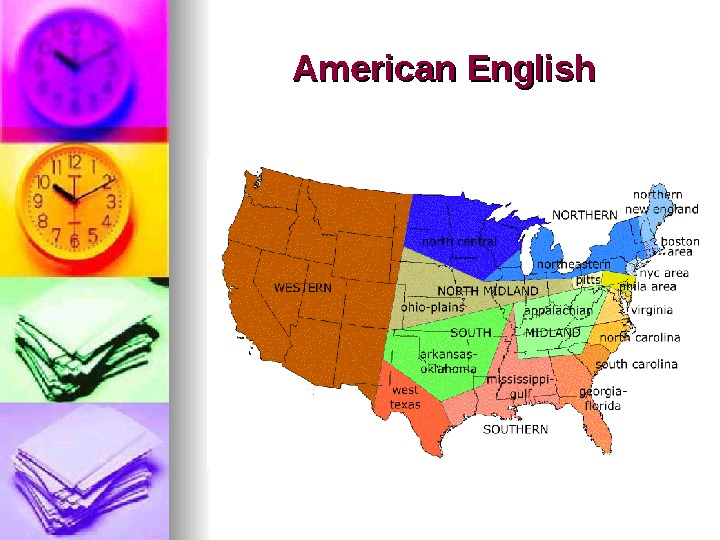
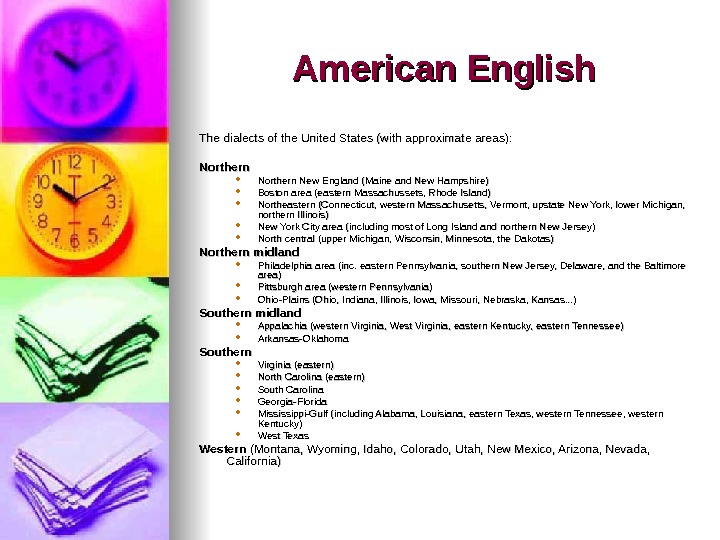
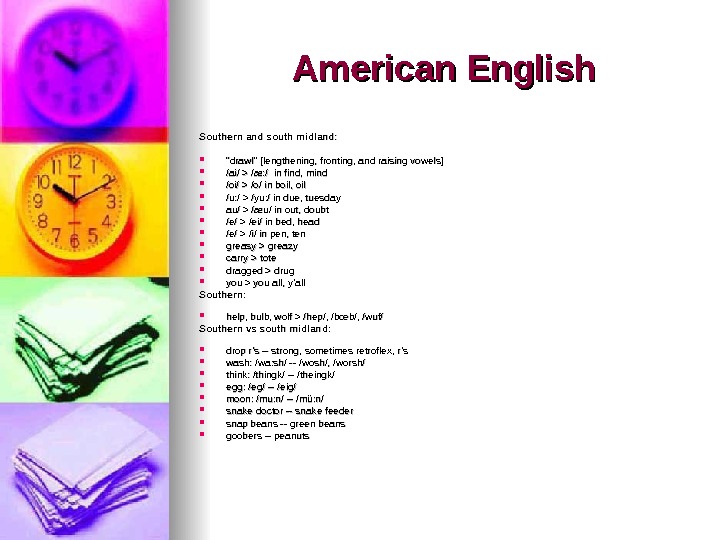
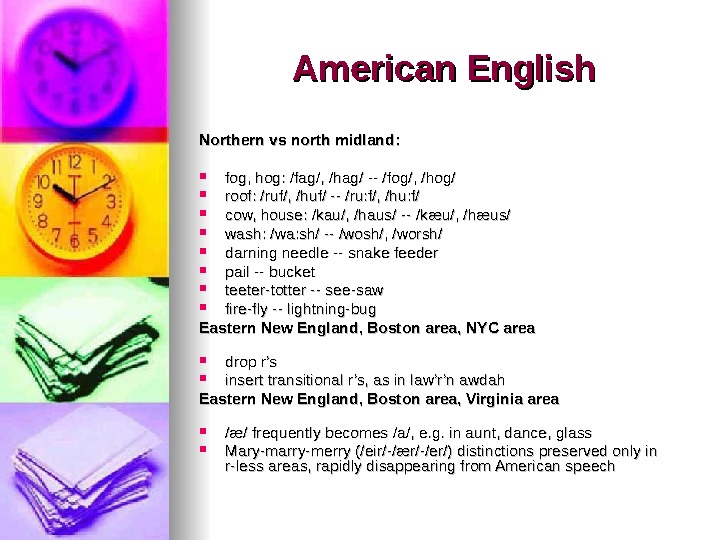
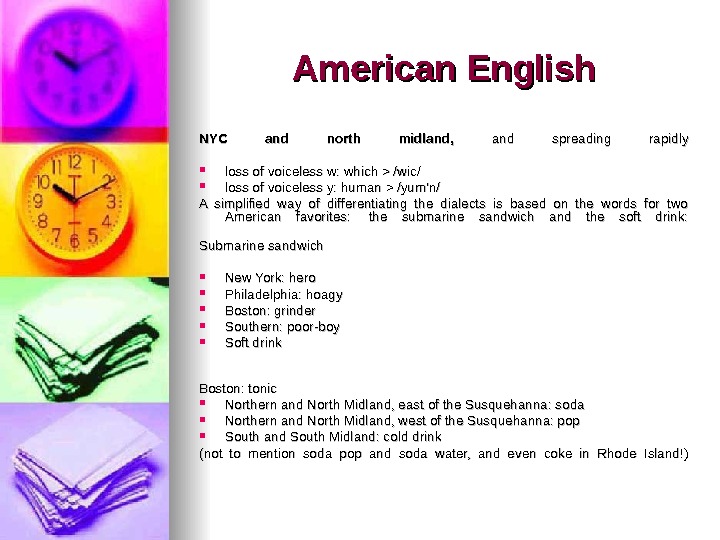
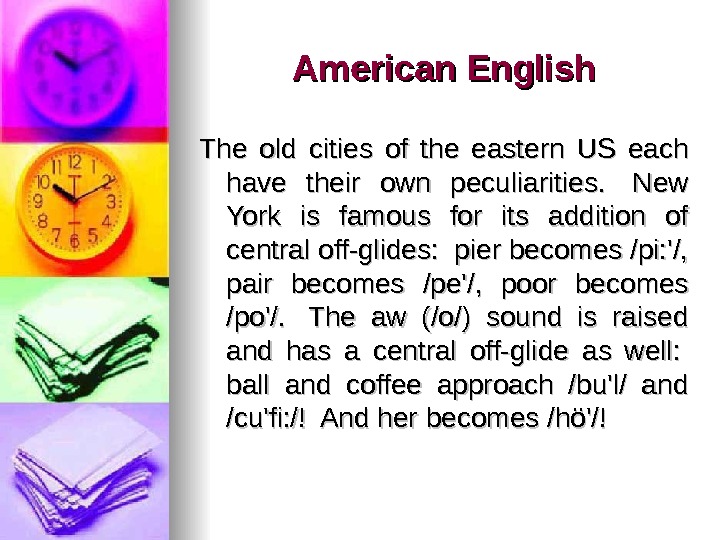
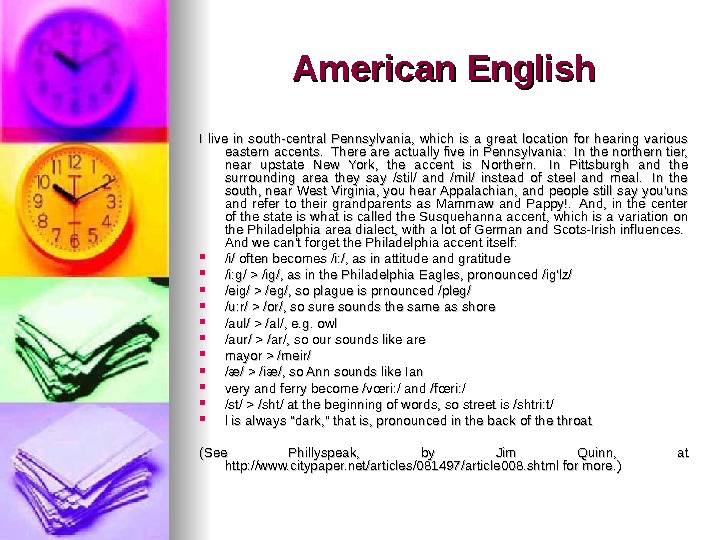
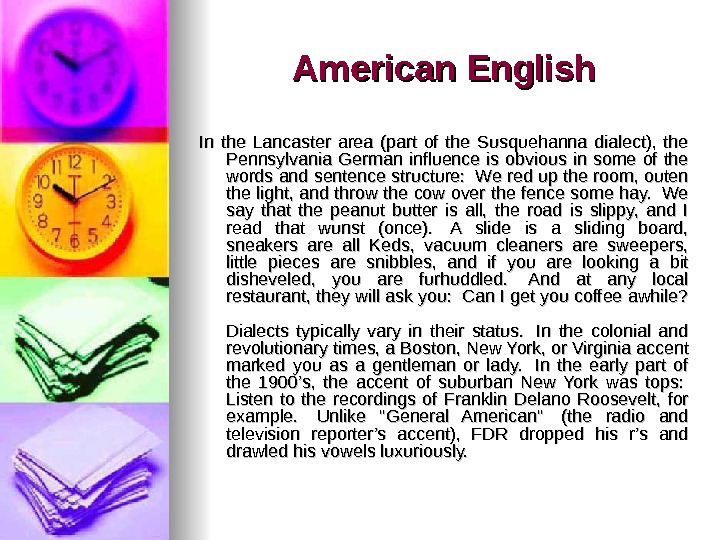
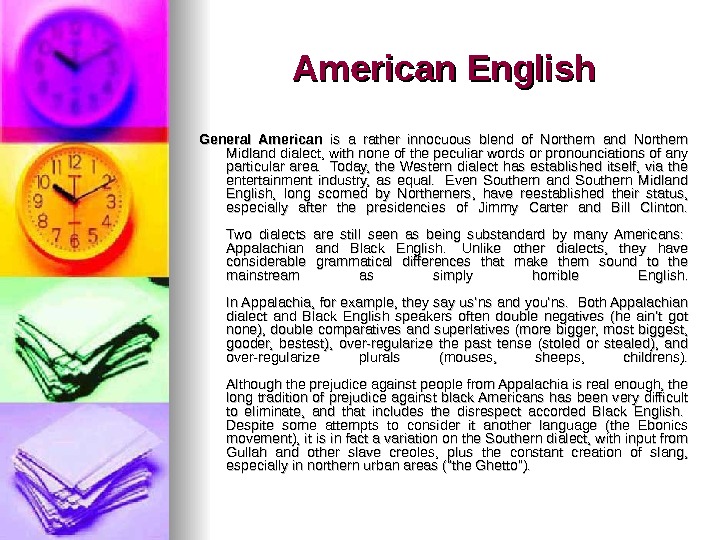
- Размер: 410 Кб
- Количество слайдов: 58
Описание презентации Dialects of English Dr. C. George Boeree по слайдам
 Dialects of English Dr. C. George Boeree
Dialects of English Dr. C. George Boeree
 DIALECT: GENERAL IDEA TT he term dialect (from the Greek word dialektos , , Διάλεκτος ) ) is used in two distinct ways, even by linguists. One usage refers to a variety of a language that is a characteristic of a particular group of the language’s speakers. . The term is applied most often to regional speech patterns, but a dialect may also be defined by other factors, such as social class. A dialect that is associated with a particular social class can be termed a sociol ectect ; a regional dialect may be termed a regiolect or topolect. The other usage refers to a language socially subordinate to a regional or national standard language, often historically cognate to the standard, but not a variety of it or in any other sense derived from it[ citation needed ]. This more precise usage enables distinguishing between varieties of a language, such as the French spoken in Nice , France, and local languages distinct from the superordinate language, e. g. Nissart , the traditional native Romance language of Nice, known in French as Niçard. .
DIALECT: GENERAL IDEA TT he term dialect (from the Greek word dialektos , , Διάλεκτος ) ) is used in two distinct ways, even by linguists. One usage refers to a variety of a language that is a characteristic of a particular group of the language’s speakers. . The term is applied most often to regional speech patterns, but a dialect may also be defined by other factors, such as social class. A dialect that is associated with a particular social class can be termed a sociol ectect ; a regional dialect may be termed a regiolect or topolect. The other usage refers to a language socially subordinate to a regional or national standard language, often historically cognate to the standard, but not a variety of it or in any other sense derived from it[ citation needed ]. This more precise usage enables distinguishing between varieties of a language, such as the French spoken in Nice , France, and local languages distinct from the superordinate language, e. g. Nissart , the traditional native Romance language of Nice, known in French as Niçard. .
 DIALECT: GENERAL IDEA A dialect is distinguished by its vocabulary, grammar, and pronunciation ( phonology , , including prosody ). Where a distinction can be made only in terms of pronunciation, the term accent is appropriate, not dialect. Other speech varieties include: standard languages , which are standardized for public performance (for example, a written standard); jargons , which are characterized by differences in lexicon ( ( vocabulary ); ); slang ; ; patois ; ; pidgins or or argots. .
DIALECT: GENERAL IDEA A dialect is distinguished by its vocabulary, grammar, and pronunciation ( phonology , , including prosody ). Where a distinction can be made only in terms of pronunciation, the term accent is appropriate, not dialect. Other speech varieties include: standard languages , which are standardized for public performance (for example, a written standard); jargons , which are characterized by differences in lexicon ( ( vocabulary ); ); slang ; ; patois ; ; pidgins or or argots. .
 DIALECT: GENERAL IDEA The particular speech patterns used by an individual are termed an an idiolect. .
DIALECT: GENERAL IDEA The particular speech patterns used by an individual are termed an an idiolect. .
 Standard and non-standard dialect A A standard dialect (also known as a standardized dialect or «standard language») is a dialect that is supported by institutions. Such institutional support may include government recognition or designation; presentation as being the «correct» form of a language in schools; published grammars, dictionaries, and textbooks that set forth a «correct» spoken and written form; and an extensive formal literature that employs that dialect (prose, poetry, non-fiction, etc. ). There may be multiple standard dialects associated with a single language. For example, Standard American English , Standard Canadian English , Standard Indian English , , Standard Australian English , and Standard Philippine English may all be said to be standard dialects of the English language. .
Standard and non-standard dialect A A standard dialect (also known as a standardized dialect or «standard language») is a dialect that is supported by institutions. Such institutional support may include government recognition or designation; presentation as being the «correct» form of a language in schools; published grammars, dictionaries, and textbooks that set forth a «correct» spoken and written form; and an extensive formal literature that employs that dialect (prose, poetry, non-fiction, etc. ). There may be multiple standard dialects associated with a single language. For example, Standard American English , Standard Canadian English , Standard Indian English , , Standard Australian English , and Standard Philippine English may all be said to be standard dialects of the English language. .
 Standard and non-standard dialect A A nonstandard dialect , like a standard dialect, has a complete vocabulary, grammar, and syntax, but is not the beneficiary of institutional support. An example of a nonstandard English dialect is Southern American English or Newfoundland English. The Dialect Test was designed by Joseph Wright to compare different English dialects with each other. The term dialect is used in two distinct ways.
Standard and non-standard dialect A A nonstandard dialect , like a standard dialect, has a complete vocabulary, grammar, and syntax, but is not the beneficiary of institutional support. An example of a nonstandard English dialect is Southern American English or Newfoundland English. The Dialect Test was designed by Joseph Wright to compare different English dialects with each other. The term dialect is used in two distinct ways.
 «Dialect» or «language» There is no universally accepted criterion for distinguishing a language from a dialect. A number of rough measures exist, sometimes leading to contradictory results. Some linguists do not differentiate between languages and dialects, i. e. languages are dialects and vice versa. The distinction is therefore subjective and depends on the user’s frame of reference. Note also that the terms are not always treated as mutually exclusive ; ; there is not necessarily anything contradictory in the statement that «the language of the Pennsylvania Dutch is a dialect of German». However, the term dialect always implies a relation between languages: if language X is called a dialect, this implies that the speaker considers X a dialect of of some other language Y, which then usually is some standard language.
«Dialect» or «language» There is no universally accepted criterion for distinguishing a language from a dialect. A number of rough measures exist, sometimes leading to contradictory results. Some linguists do not differentiate between languages and dialects, i. e. languages are dialects and vice versa. The distinction is therefore subjective and depends on the user’s frame of reference. Note also that the terms are not always treated as mutually exclusive ; ; there is not necessarily anything contradictory in the statement that «the language of the Pennsylvania Dutch is a dialect of German». However, the term dialect always implies a relation between languages: if language X is called a dialect, this implies that the speaker considers X a dialect of of some other language Y, which then usually is some standard language.
 «Dialect» or «language» Language varieties are often called dialects rather than languages : : if they have no standard or codified form, if the speakers of the given language do not have a state of their own, if they are rarely or never used in writing (outside reported speech), if they lack prestige with respect to some other, often standardised, variety.
«Dialect» or «language» Language varieties are often called dialects rather than languages : : if they have no standard or codified form, if the speakers of the given language do not have a state of their own, if they are rarely or never used in writing (outside reported speech), if they lack prestige with respect to some other, often standardised, variety.
 «Dialect» or «language» Anthropological linguists define dialect as the specific form of a language used by a speech community. [ citation needed ] In other words, the difference between language and dialect is the difference between the abstract or general and the concrete and particular. From this perspective, everyone speaks a dialect. Those who identify a particular dialect as the «standard» or «proper» version of a language are in fact using these terms to express a social distinction. Often, the standard language is close to the sociolect of the elite class.
«Dialect» or «language» Anthropological linguists define dialect as the specific form of a language used by a speech community. [ citation needed ] In other words, the difference between language and dialect is the difference between the abstract or general and the concrete and particular. From this perspective, everyone speaks a dialect. Those who identify a particular dialect as the «standard» or «proper» version of a language are in fact using these terms to express a social distinction. Often, the standard language is close to the sociolect of the elite class.
 «Dialect» or «language» The status of language is not solely determined by linguistic criteria, but it is also the result of a historical and political development. Romansh came to be a written language, and therefore it is recognized as a language, even though it is very close to the Lombardic alpine dialects. An opposite example is the case of Chinese, whose variations such as Mandarin and Cantonese are often called dialects and not languages, despite their mutual unintelligibility, because the word for them in Mandarin, 方 方 fāngyán , was mistranslated as «dialect» because it meant «regional speech“. .
«Dialect» or «language» The status of language is not solely determined by linguistic criteria, but it is also the result of a historical and political development. Romansh came to be a written language, and therefore it is recognized as a language, even though it is very close to the Lombardic alpine dialects. An opposite example is the case of Chinese, whose variations such as Mandarin and Cantonese are often called dialects and not languages, despite their mutual unintelligibility, because the word for them in Mandarin, 方 方 fāngyán , was mistranslated as «dialect» because it meant «regional speech“. .
 THE DIALECTS OF BRITISH ENGLISH Southern English engages in r-dropping, that is, r’s are not pronounced after vowels, unless followed by another vowel. Instead, vowels are lengthened or have an /’/ off-glide, so fire becomes /fai’/, far becomes /fa: /, and so on. regular use of «broad a» (/a: /), where GA (General American) would use /æ/. «long o» is pronounced /’u/, where GA uses /ou/. final unstressed i is pronounced /i/, where GA uses /i: ). t between vowels retained as /t/ (or a glottal stop, in its variants), where GA changes it to /d/. The English of well-bred Londoners, especially graduates of the public schools (e. g. Eton and Harrow) and «Oxbridge» universities, was the origin of «the Queen’s English, » also known as as Received Pronunciation (RP), BBC, or «posh. «
THE DIALECTS OF BRITISH ENGLISH Southern English engages in r-dropping, that is, r’s are not pronounced after vowels, unless followed by another vowel. Instead, vowels are lengthened or have an /’/ off-glide, so fire becomes /fai’/, far becomes /fa: /, and so on. regular use of «broad a» (/a: /), where GA (General American) would use /æ/. «long o» is pronounced /’u/, where GA uses /ou/. final unstressed i is pronounced /i/, where GA uses /i: ). t between vowels retained as /t/ (or a glottal stop, in its variants), where GA changes it to /d/. The English of well-bred Londoners, especially graduates of the public schools (e. g. Eton and Harrow) and «Oxbridge» universities, was the origin of «the Queen’s English, » also known as as Received Pronunciation (RP), BBC, or «posh. «
 THE DIALECTS OF BRITISH ENGLISH Cockney Originally the dialect of the working class of East End London.
THE DIALECTS OF BRITISH ENGLISH Cockney Originally the dialect of the working class of East End London.
 THE DIALECTS OF BRITISH ENGLISH Besides the accent, it includes a large number of slang words, including the famous rhyming slang:
THE DIALECTS OF BRITISH ENGLISH Besides the accent, it includes a large number of slang words, including the famous rhyming slang:
 THE DIALECTS OF BRITISH ENGLISH have a butchers — take a look [from butcher’s hook = look] north and south — mouth plates — feet [from plates of meat = feet] boat race — face skin and blister — sister trouble — wife [from trouble and strife = wife] dustbin lids — kids / children whistle — suit [from whistle and flute = suit] oily rag — fag = cigarette jam jar — car mince pies — eyes pen and ink — stink porkies — lies [from pork pies = lies] titfer — hat [from tit for tat = hat] apples and pears — stairs Jimmy — urinate [from Jimmy Riddle = piddle] Bertie Woofter — gay man [from Bertie Woofter = poofter] China — mate / friend [from China plate = mate] Khyber — buttocks [from Khyber Pass = ass] rabbit and pork — talk tea leaf — thief taters — cold [from potato mold = cold] dog and bone — phone loaf — head [from loaf of bread = head]
THE DIALECTS OF BRITISH ENGLISH have a butchers — take a look [from butcher’s hook = look] north and south — mouth plates — feet [from plates of meat = feet] boat race — face skin and blister — sister trouble — wife [from trouble and strife = wife] dustbin lids — kids / children whistle — suit [from whistle and flute = suit] oily rag — fag = cigarette jam jar — car mince pies — eyes pen and ink — stink porkies — lies [from pork pies = lies] titfer — hat [from tit for tat = hat] apples and pears — stairs Jimmy — urinate [from Jimmy Riddle = piddle] Bertie Woofter — gay man [from Bertie Woofter = poofter] China — mate / friend [from China plate = mate] Khyber — buttocks [from Khyber Pass = ass] rabbit and pork — talk tea leaf — thief taters — cold [from potato mold = cold] dog and bone — phone loaf — head [from loaf of bread = head]
 THE DIALECTS OF BRITISH ENGLISH initial h is dropped, so house becomes /aus/ (or even /a: s/). /th/ and /dh/ become /f/ and /v/ respectively: think > /fingk/, brother > /brœv’/. t between vowels becomes a glottal stop: water > /wo? i/. diphthongs change, sometimes dramatically: time > /toim/, brave > /braiv/, etc. brown bread — dead elbows and knees — trees gold watch — Scotch pride and joy — boy current bun — Sun dicky — shirt [from dicky dirt = shirt] pots and pans — hands jugs — ears [from jugs of beers = ears] ones and twos — shoes daisies — boots [from daisy roots = boots] bird — prison [from bird lime = time, as in doing time] (from Kryss Katsiavriades at http: //www. krysstal. com/cockney. html)
THE DIALECTS OF BRITISH ENGLISH initial h is dropped, so house becomes /aus/ (or even /a: s/). /th/ and /dh/ become /f/ and /v/ respectively: think > /fingk/, brother > /brœv’/. t between vowels becomes a glottal stop: water > /wo? i/. diphthongs change, sometimes dramatically: time > /toim/, brave > /braiv/, etc. brown bread — dead elbows and knees — trees gold watch — Scotch pride and joy — boy current bun — Sun dicky — shirt [from dicky dirt = shirt] pots and pans — hands jugs — ears [from jugs of beers = ears] ones and twos — shoes daisies — boots [from daisy roots = boots] bird — prison [from bird lime = time, as in doing time] (from Kryss Katsiavriades at http: //www. krysstal. com/cockney. html)
 THE DIALECTS OF BRITISH ENGLISH Estuary English From London down the Thames and into Essex, Sussex, and even Kent, a new working and middle class dialect has evolved and is rapidly become «the» southern dialect. It combines some of the characteristics of Cockney with RP, but makes much less use of Cockney slang.
THE DIALECTS OF BRITISH ENGLISH Estuary English From London down the Thames and into Essex, Sussex, and even Kent, a new working and middle class dialect has evolved and is rapidly become «the» southern dialect. It combines some of the characteristics of Cockney with RP, but makes much less use of Cockney slang.
 THE DIALECTS OF BRITISH ENGLISH East Anglian This dialect is very similar to the Southern: t between vowels usually becomes a glottal stop. /ai/ becomes /oi/: time > /toim/. RP yu becomes u: after n, t, d. . . as in American English.
THE DIALECTS OF BRITISH ENGLISH East Anglian This dialect is very similar to the Southern: t between vowels usually becomes a glottal stop. /ai/ becomes /oi/: time > /toim/. RP yu becomes u: after n, t, d. . . as in American English.
 THE DIALECTS OF BRITISH ENGLISH East Midlands The dialect of the East Midlands, once filled with interesting variations from county to county, is now predominantly RP. R’s are dropped, but h’s are pronounced. The only signs that differentiate it from RP: ou > u: (so go becomes /gu: /). RP yu; becomes u: after n, t, d. . . as in American English. The West Country r’s are not dropped. initial s often becomes z (singer > zinger). initial f often becomes v (finger > vinger). vowels are lengthened.
THE DIALECTS OF BRITISH ENGLISH East Midlands The dialect of the East Midlands, once filled with interesting variations from county to county, is now predominantly RP. R’s are dropped, but h’s are pronounced. The only signs that differentiate it from RP: ou > u: (so go becomes /gu: /). RP yu; becomes u: after n, t, d. . . as in American English. The West Country r’s are not dropped. initial s often becomes z (singer > zinger). initial f often becomes v (finger > vinger). vowels are lengthened.
 THE DIALECTS OF BRITISH ENGLISH West Midlands This is the dialect of Ozzie Osbourne! While pronunciation is not that different from RP, some of the vocabulary is: are > am am, are (with a continuous sense) > bin is not > ay are not > bay Brummie is the version of West Midlands spoken in Birmingham.
THE DIALECTS OF BRITISH ENGLISH West Midlands This is the dialect of Ozzie Osbourne! While pronunciation is not that different from RP, some of the vocabulary is: are > am am, are (with a continuous sense) > bin is not > ay are not > bay Brummie is the version of West Midlands spoken in Birmingham.
 THE DIALECTS OF BRITISH ENGLISH Lancashire This dialect, spoken north and east of Liverpool, has the southern habit of dropping r’s. Other features: /œ/ > /u/, as in luck (/luk/). /ou/ > /oi/, as in hole (/hoil/) Scouse is the very distinctive Liverpool accent, a version of the Lancashire dialect, that the Beatles made famous. the tongue is drawn back. /th/ and /dh/ > /t/ and /d/ respectively. final k sounds like the Arabic q. for is pronounced to rhyme with fur.
THE DIALECTS OF BRITISH ENGLISH Lancashire This dialect, spoken north and east of Liverpool, has the southern habit of dropping r’s. Other features: /œ/ > /u/, as in luck (/luk/). /ou/ > /oi/, as in hole (/hoil/) Scouse is the very distinctive Liverpool accent, a version of the Lancashire dialect, that the Beatles made famous. the tongue is drawn back. /th/ and /dh/ > /t/ and /d/ respectively. final k sounds like the Arabic q. for is pronounced to rhyme with fur.
 THE DIALECTS OF BRITISH ENGLISH Yorkshire The Yorkshire dialect is known for its sing-song quality, a little like Swedish, and retains its r’s. /œ/ > /u/, as in luck (/luk/). the is reduced to t’. initial h is dropped. was > were. still use thou (pronounced /tha/) and thee. aught and naught (pronounced /aut/ or /out/ and /naut/ or /nout/) are used for anything and nothing.
THE DIALECTS OF BRITISH ENGLISH Yorkshire The Yorkshire dialect is known for its sing-song quality, a little like Swedish, and retains its r’s. /œ/ > /u/, as in luck (/luk/). the is reduced to t’. initial h is dropped. was > were. still use thou (pronounced /tha/) and thee. aught and naught (pronounced /aut/ or /out/ and /naut/ or /nout/) are used for anything and nothing.
 THE DIALECTS OF BRITISH ENGLISH Northern The Northern dialect closely resembles the southern-most Scottish dialects. It retains many old Scandinavian words, such as bairn for child, and not only keeps its r’s, but often rolls them. The most outstanding version is Geordie , the dialect of the Newcastle area. -er > /æ/, so father > /fædhæ/. /ou/ > /o: ‘/, so that boat sounds like each letter is pronounced. talk > /ta: k/ work > /work/ book > /bu: k/ my > me me > us our > wor you plural > youse
THE DIALECTS OF BRITISH ENGLISH Northern The Northern dialect closely resembles the southern-most Scottish dialects. It retains many old Scandinavian words, such as bairn for child, and not only keeps its r’s, but often rolls them. The most outstanding version is Geordie , the dialect of the Newcastle area. -er > /æ/, so father > /fædhæ/. /ou/ > /o: ‘/, so that boat sounds like each letter is pronounced. talk > /ta: k/ work > /work/ book > /bu: k/ my > me me > us our > wor you plural > youse
 Wales WW elsh English is characterized by a sing-song quality and lightly rolled r’s. It has been strongly influenced by the Welsh language, although it is increasingly influenced today by standard English, due to the large number of English people vacationing and retiring there. THE DIALECTS OF BRITISH ENGLISH
Wales WW elsh English is characterized by a sing-song quality and lightly rolled r’s. It has been strongly influenced by the Welsh language, although it is increasingly influenced today by standard English, due to the large number of English people vacationing and retiring there. THE DIALECTS OF BRITISH ENGLISH
 THE DIALECTS OF BRITISH ENGLISH Scotland actually has more variation in dialects than England! The variations do have a few things in common, though, besides a large particularly Scottish vocabulary: rolled r’s. «pure» vowels (/e: / rather than /ei/, /o: / rather than /ou/) /u: / is often fronted to /ö/ or /ü/, e. g. boot, good, muin (moon), poor. . .
THE DIALECTS OF BRITISH ENGLISH Scotland actually has more variation in dialects than England! The variations do have a few things in common, though, besides a large particularly Scottish vocabulary: rolled r’s. «pure» vowels (/e: / rather than /ei/, /o: / rather than /ou/) /u: / is often fronted to /ö/ or /ü/, e. g. boot, good, muin (moon), poor. . .
 THE DIALECTS OF BRITISH ENGLISH There are several «layers» of Scottish English. Most people today speak standard English with little more than the changes just mentioned, plus a few particular words that they themselves view as normal English, such as to jag (to prick) and burn (brook). In rural areas, many older words and grammatical forms, as well as further phonetic variations, still survive, but are being rapidly replaced with more standard forms. But when a Scotsman (or woman) wants to show his pride in his heritage, he may resort to quite a few traditional variations in his speech. First, the phonetics:
THE DIALECTS OF BRITISH ENGLISH There are several «layers» of Scottish English. Most people today speak standard English with little more than the changes just mentioned, plus a few particular words that they themselves view as normal English, such as to jag (to prick) and burn (brook). In rural areas, many older words and grammatical forms, as well as further phonetic variations, still survive, but are being rapidly replaced with more standard forms. But when a Scotsman (or woman) wants to show his pride in his heritage, he may resort to quite a few traditional variations in his speech. First, the phonetics:
 THE DIALECTS OF BRITISH ENGLISH /oi/, /ai/, and final /ei/ > /’i/, e. g. oil, wife, tide. . . final /ai/ > /i/, e. g. ee (eye), dee (die), lee (lie). . . /ou/ > /e/, e. g. ake (oak), bate (boat), hame (home), stane (stone), gae (go). . . /au/ > /u/, e. g. about, house, cow, now. . . (often spelled oo or u) /o/ > /a: /, e. g. saut (salt), law, aw (all). . . /ou/ > /a: /, e. g. auld (old), cauld (cold), snaw (snow). . . /æ/ > /a/, e. g. man, lad, sat. . . also: pronounce the ch’s and gh’s that are silent in standard English: nicht, licht, loch. . .
THE DIALECTS OF BRITISH ENGLISH /oi/, /ai/, and final /ei/ > /’i/, e. g. oil, wife, tide. . . final /ai/ > /i/, e. g. ee (eye), dee (die), lee (lie). . . /ou/ > /e/, e. g. ake (oak), bate (boat), hame (home), stane (stone), gae (go). . . /au/ > /u/, e. g. about, house, cow, now. . . (often spelled oo or u) /o/ > /a: /, e. g. saut (salt), law, aw (all). . . /ou/ > /a: /, e. g. auld (old), cauld (cold), snaw (snow). . . /æ/ > /a/, e. g. man, lad, sat. . . also: pronounce the ch’s and gh’s that are silent in standard English: nicht, licht, loch. . .
 THE DIALECTS OF BRITISH ENGLISH Plus, the grammar: Present tense: often, all forms follow the third person singular (they wis, instead of they were). Past tense (weak verbs): -it after plosives (big > biggit); -t after n, l, r, and all other unvoiced consonants (ken > kent); -ed after vowels and all other voiced consonants (luv > luved). Past tense (strong verbs): come > cam, gang > gaed and many more. On the other hand, many verbs that are strong in standard English are weak in Scottish English: sell > sellt, tell > tellt, mak > makkit, see > seed, etc. Past participle is usually the same as the past (except for many strong verbs, as in standard English) Present participle: -in (ken > kennin) The negative of many auxiliary verbs is formed with -na: am > amna, hae (have) > hinna, dae (do) > dinna, can > canna, etc. Irregular plurals: ee > een (eyes), shae > shuin (shoes), coo > kye (cows). Common diminutives in -ie: lass > lassie, hoose > hoosie. . . Common adjective ending: -lik (= -ish) Demonstratives come in four pairs (singular/plural): this/thir, that/thae, thon/thon, yon/yon. Relative pronouns: tha or at. Interrogative pronouns: hoo, wha, whan, whase, whaur, whatna, whit. Each or every is ilka; each one is ilk ane. Numbers: ane, twa, three, fower, five, sax, seeven, aucht, nine, ten, aleeven, twal. . .
THE DIALECTS OF BRITISH ENGLISH Plus, the grammar: Present tense: often, all forms follow the third person singular (they wis, instead of they were). Past tense (weak verbs): -it after plosives (big > biggit); -t after n, l, r, and all other unvoiced consonants (ken > kent); -ed after vowels and all other voiced consonants (luv > luved). Past tense (strong verbs): come > cam, gang > gaed and many more. On the other hand, many verbs that are strong in standard English are weak in Scottish English: sell > sellt, tell > tellt, mak > makkit, see > seed, etc. Past participle is usually the same as the past (except for many strong verbs, as in standard English) Present participle: -in (ken > kennin) The negative of many auxiliary verbs is formed with -na: am > amna, hae (have) > hinna, dae (do) > dinna, can > canna, etc. Irregular plurals: ee > een (eyes), shae > shuin (shoes), coo > kye (cows). Common diminutives in -ie: lass > lassie, hoose > hoosie. . . Common adjective ending: -lik (= -ish) Demonstratives come in four pairs (singular/plural): this/thir, that/thae, thon/thon, yon/yon. Relative pronouns: tha or at. Interrogative pronouns: hoo, wha, whan, whase, whaur, whatna, whit. Each or every is ilka; each one is ilk ane. Numbers: ane, twa, three, fower, five, sax, seeven, aucht, nine, ten, aleeven, twal. . .
 THE DIALECTS OF BRITISH ENGLISH And finally, the many unique words: lass, bairn (child), kirk (church), big (build), bonny, greet (weep), ingle (household fire), aye (yes), hame (home). . . As you can see, Scottish English in its original glory is as near to being different language as one can get, rather than simply another dialect of English. See Clive P L Young’s Scots Haunbuik at http: //www. electricscotland. com/tourist/sh_gram. htm for more detail. There are also several urban dialects, particularly in Glasgow and Edinburgh. The thick dialect of the working class of Edinburgh can be heard in the movie Trainspotting. In the Highlands, especially the Western Islands, English is often people’s second language, the first being Scottish Gaelic. Highland English is pronounced in a lilting fashion with pure vowels. It is, actually, one of the prettiest varieties of English one may ever hear.
THE DIALECTS OF BRITISH ENGLISH And finally, the many unique words: lass, bairn (child), kirk (church), big (build), bonny, greet (weep), ingle (household fire), aye (yes), hame (home). . . As you can see, Scottish English in its original glory is as near to being different language as one can get, rather than simply another dialect of English. See Clive P L Young’s Scots Haunbuik at http: //www. electricscotland. com/tourist/sh_gram. htm for more detail. There are also several urban dialects, particularly in Glasgow and Edinburgh. The thick dialect of the working class of Edinburgh can be heard in the movie Trainspotting. In the Highlands, especially the Western Islands, English is often people’s second language, the first being Scottish Gaelic. Highland English is pronounced in a lilting fashion with pure vowels. It is, actually, one of the prettiest varieties of English one may ever hear.
 THE DIALECTS OF BRITISH ENGLISH English was imposed upon the Irish, but they have made it their own and have contributed some of our finest literature. Irish English is strongly influenced by Irish Gaelic: r after vowels is retained «pure» vowels (/e: / rather than /ei/, /o: / rather than /ou/) /th/ and /dh/ > /t/ and /d/ respectively.
THE DIALECTS OF BRITISH ENGLISH English was imposed upon the Irish, but they have made it their own and have contributed some of our finest literature. Irish English is strongly influenced by Irish Gaelic: r after vowels is retained «pure» vowels (/e: / rather than /ei/, /o: / rather than /ou/) /th/ and /dh/ > /t/ and /d/ respectively.
 THE DIALECTS OF BRITISH ENGLISH The sentence structure of Irish English often borrows from the Gaelic: Use of bebe or or dodo in place of usually : : I I dodo write. . . (I usually write) Use of after for the progressive perfect and pluperfect: I was after getting married (I had just gotten married) Use of progressive beyond what is possible in standard English: I I was thinking it was in the drawer Use of the present or past for perfect and pluperfect: She’s dead these ten years (she has been dead. . . ) Use of let you be and don’t be as the imperative: Don’t be troubling yourself Use of it is and it was at the beginning of a sentence: it was John has the good looks in the family Is it marrying her you want?
THE DIALECTS OF BRITISH ENGLISH The sentence structure of Irish English often borrows from the Gaelic: Use of bebe or or dodo in place of usually : : I I dodo write. . . (I usually write) Use of after for the progressive perfect and pluperfect: I was after getting married (I had just gotten married) Use of progressive beyond what is possible in standard English: I I was thinking it was in the drawer Use of the present or past for perfect and pluperfect: She’s dead these ten years (she has been dead. . . ) Use of let you be and don’t be as the imperative: Don’t be troubling yourself Use of it is and it was at the beginning of a sentence: it was John has the good looks in the family Is it marrying her you want?
 THE DIALECTS OF BRITISH ENGLISH Substitute andand for when or or asas : : It only struck me andand you going out of the door Substitute the infinitive verb for that or or ifif : : Imagine such a thing to be seen here! Drop ifif , , that , or whether : : Tell me did you see them Statements phrased as rhetorical questions: Isn’t he the fine-looking fellow? Extra uses of the definite article: He was sick with thethe jaundice Unusual use of prepositions: Sure there’s no daylight inin it at all now As with the English of the Scottish Highlands, the English of the west coast of Ireland, where Gaelic is still spoken, is lilting, with pure vowels. It, too, is particularly pretty.
THE DIALECTS OF BRITISH ENGLISH Substitute andand for when or or asas : : It only struck me andand you going out of the door Substitute the infinitive verb for that or or ifif : : Imagine such a thing to be seen here! Drop ifif , , that , or whether : : Tell me did you see them Statements phrased as rhetorical questions: Isn’t he the fine-looking fellow? Extra uses of the definite article: He was sick with thethe jaundice Unusual use of prepositions: Sure there’s no daylight inin it at all now As with the English of the Scottish Highlands, the English of the west coast of Ireland, where Gaelic is still spoken, is lilting, with pure vowels. It, too, is particularly pretty.
 AUSTRALIAN ENGLISH Australian English is predominantly British English, and especially from the London area. R’s are dropped after vowels, but are often inserted between two words ending and beginning with vowels. The vowels reflect a strong “Cockney” influence: The long a (/ei/) tends towards a long i (/ai/), so pay sounds like pie to an American ear. The long i (/ai/), in turn, tends towards oi, so cry sounds like croy. Ow sounds like it starts with a short a (/æ/). Other vowels are less dramatically shifted. Even some rhyming slang has survived into Australlian English: Butcher’s means look (butcher’s hook); hit and miss means piss; loaf means head (loaf of bread); Noah’s ark means shark; Richard the third means turd, and so on. Like American English has absorbed numerous American Indian words, Australian English has absorbed many Aboriginal words: billibong — watering hole coolabah — a type of tree corroboree — a ceremony nulla-nulla — a club wallaby — small kangaroo wombat — a small marsupial woomera — a weapon wurley — a simple shelter . . . not to mention such ubiquitous words as kangaroo, boomerang, and koala!
AUSTRALIAN ENGLISH Australian English is predominantly British English, and especially from the London area. R’s are dropped after vowels, but are often inserted between two words ending and beginning with vowels. The vowels reflect a strong “Cockney” influence: The long a (/ei/) tends towards a long i (/ai/), so pay sounds like pie to an American ear. The long i (/ai/), in turn, tends towards oi, so cry sounds like croy. Ow sounds like it starts with a short a (/æ/). Other vowels are less dramatically shifted. Even some rhyming slang has survived into Australlian English: Butcher’s means look (butcher’s hook); hit and miss means piss; loaf means head (loaf of bread); Noah’s ark means shark; Richard the third means turd, and so on. Like American English has absorbed numerous American Indian words, Australian English has absorbed many Aboriginal words: billibong — watering hole coolabah — a type of tree corroboree — a ceremony nulla-nulla — a club wallaby — small kangaroo wombat — a small marsupial woomera — a weapon wurley — a simple shelter . . . not to mention such ubiquitous words as kangaroo, boomerang, and koala!
 AUSTRALIAN ENGLISH Aborigine and colonialist myths blended easily, and there are a number of fearsome creatures. For example, the bunyip lives near bilibongs and eats children. Also living in bilibongs is the mindi, a hairy snake. A yowie is the Australian version of Sasquatch. And the min-min light is their version of a will-o-the-wisp. Many common words refer to the traditions of the bushman or bushie — the early explorers and settlers of the outback (wilderness). You can find many of these in Australia’s national song, Waltzing Matilda. billy — tin pot for making tea cooee — call used in the outback dingo — native dog jackeroo — young station hand joey — young kangaroo jumbuck — sheep matilda — backpack never-never — the far outback squatter — rancher station — ranch swagman — bushman or tramp tucker — food
AUSTRALIAN ENGLISH Aborigine and colonialist myths blended easily, and there are a number of fearsome creatures. For example, the bunyip lives near bilibongs and eats children. Also living in bilibongs is the mindi, a hairy snake. A yowie is the Australian version of Sasquatch. And the min-min light is their version of a will-o-the-wisp. Many common words refer to the traditions of the bushman or bushie — the early explorers and settlers of the outback (wilderness). You can find many of these in Australia’s national song, Waltzing Matilda. billy — tin pot for making tea cooee — call used in the outback dingo — native dog jackeroo — young station hand joey — young kangaroo jumbuck — sheep matilda — backpack never-never — the far outback squatter — rancher station — ranch swagman — bushman or tramp tucker — food
 AUSTRALIAN ENGLISH Colorful expressions also abound: Like a greasespot — hot and sweaty Like a stunned mullet — in a daze Like a dog’s breakfast — a mess Up a gumtree — in trouble Mad as a gumtree full of galahs — insane Happy as a bastard on Fathers’ Day — very happy Dry as a dead dingo’s donger — very dry indeed
AUSTRALIAN ENGLISH Colorful expressions also abound: Like a greasespot — hot and sweaty Like a stunned mullet — in a daze Like a dog’s breakfast — a mess Up a gumtree — in trouble Mad as a gumtree full of galahs — insane Happy as a bastard on Fathers’ Day — very happy Dry as a dead dingo’s donger — very dry indeed
 AUSTRALIAN ENGLISH Another characteristic of Australian English is abbreviated words, often ending in -y, -ie, or -o: aussie — Australian chalky — teacher chewie — chewing gum chockie — chocoloate coldie — a cold beer cossie — swimming costume (swimsuit) footy — football (Australian rules, of course) frenchie — condom frostie — a cold beer garbo — garbage man lavvy — lavatory
AUSTRALIAN ENGLISH Another characteristic of Australian English is abbreviated words, often ending in -y, -ie, or -o: aussie — Australian chalky — teacher chewie — chewing gum chockie — chocoloate coldie — a cold beer cossie — swimming costume (swimsuit) footy — football (Australian rules, of course) frenchie — condom frostie — a cold beer garbo — garbage man lavvy — lavatory
 AUSTRALIAN ENGLISH lippie — lipstick lollies — sweets mossie — mosquito mushies — mushrooms oldies — one’s parents rellies — one’s relatives sammie — sandwich sickie — sick day smoko — cigarette break sunnies — sunglasses And, of course, there are those peculiarly Australian words and expressions, such as g’day (guhdoy to American ears), crikey, fair dinkum, no worries, Oz, Pavlova, and Vegemite!
AUSTRALIAN ENGLISH lippie — lipstick lollies — sweets mossie — mosquito mushies — mushrooms oldies — one’s parents rellies — one’s relatives sammie — sandwich sickie — sick day smoko — cigarette break sunnies — sunglasses And, of course, there are those peculiarly Australian words and expressions, such as g’day (guhdoy to American ears), crikey, fair dinkum, no worries, Oz, Pavlova, and Vegemite!
 NEW ZEALAND New Zealand English is heard by Americans as «Ozzie Light. » The characteristics of Australian English are there to some degree, but not as intensely. The effect for Americans is uncertainty as to whether the person is from England or Australia. One clue is that New Zealand English sound «flatter» (less modulated) than either Australian or British English and more like western American English.
NEW ZEALAND New Zealand English is heard by Americans as «Ozzie Light. » The characteristics of Australian English are there to some degree, but not as intensely. The effect for Americans is uncertainty as to whether the person is from England or Australia. One clue is that New Zealand English sound «flatter» (less modulated) than either Australian or British English and more like western American English.
 SOUTH AFRICA South African English is close to RP but often with a Dutch influence. English as spoken by Afrikaaners is more clearly influenced by Dutch pronunciation. Just like Australian and American English, there are numberous words adopted from the surrounding African languages, especially for native species of animals and plants. As spoken by black South Africans for whom it is not their first language, it often reflects the pronunciation of their Bantu languages, with purer vowels. Listen, for example, to Nelson Mandela or Bishop Tutu.
SOUTH AFRICA South African English is close to RP but often with a Dutch influence. English as spoken by Afrikaaners is more clearly influenced by Dutch pronunciation. Just like Australian and American English, there are numberous words adopted from the surrounding African languages, especially for native species of animals and plants. As spoken by black South Africans for whom it is not their first language, it often reflects the pronunciation of their Bantu languages, with purer vowels. Listen, for example, to Nelson Mandela or Bishop Tutu.
 SOUTH AFRICA Here are some examples : : i — as in bit is pronounced ‘uh’ long /a: / in words like ‘past’, ‘dance’ t in middle of words pronounced as d’s (‘pretty’ becomes ‘/pridi: /’) donga — ditch, from Xhosa dagga — marijuana, from Xhoixhoi (? ) kak — bullshit, from Afrikaans fundi — expert, from Xhosa and Zulu umfundi (student).
SOUTH AFRICA Here are some examples : : i — as in bit is pronounced ‘uh’ long /a: / in words like ‘past’, ‘dance’ t in middle of words pronounced as d’s (‘pretty’ becomes ‘/pridi: /’) donga — ditch, from Xhosa dagga — marijuana, from Xhoixhoi (? ) kak — bullshit, from Afrikaans fundi — expert, from Xhosa and Zulu umfundi (student).
 Dialects also varies slightly from east to west: In Natal (in western South Africa), /ai/ is pronounced /a: /, so that why is pronounced /wa: /. On top of all this, the dialects of the ethnic group referred to in South Africa as «Coloured» (i. e. of mixed racial backgrounds) have a dialect quite distinct from the dialects of «white» South Africans. Alan also suggests that South African has a «flatter» (less modulated) sound, similar to that of New Zealand as contrasted with Australian English
Dialects also varies slightly from east to west: In Natal (in western South Africa), /ai/ is pronounced /a: /, so that why is pronounced /wa: /. On top of all this, the dialects of the ethnic group referred to in South Africa as «Coloured» (i. e. of mixed racial backgrounds) have a dialect quite distinct from the dialects of «white» South Africans. Alan also suggests that South African has a «flatter» (less modulated) sound, similar to that of New Zealand as contrasted with Australian English
 CANADA Canadian English is generally similar to northern and western American English. The one outstanding characteristic is called Canadian rising: /ai/ and /au/ become /œi/ and /œu/, respectively. Americans can listen to the newscaster Peter Jennings — one of the best voices on the telly! — for these sounds. One unusual characteristic found in much Canadian casual speech is the use of sentence final «eh? » even in declarative sentences. Most Canadians retain r’s after vowels, but in the Maritimes, they drop their r’s, just like their New England neighbors to the south. Newfoundland has a very different dialect, called Newfie, that seems to be strongly influenced by Irish immigrants: /th/ and /dh/ > /t/ and /d/ respectively. am, is, are > be’s I like, we like, etc. > I likes, we likes, etc.
CANADA Canadian English is generally similar to northern and western American English. The one outstanding characteristic is called Canadian rising: /ai/ and /au/ become /œi/ and /œu/, respectively. Americans can listen to the newscaster Peter Jennings — one of the best voices on the telly! — for these sounds. One unusual characteristic found in much Canadian casual speech is the use of sentence final «eh? » even in declarative sentences. Most Canadians retain r’s after vowels, but in the Maritimes, they drop their r’s, just like their New England neighbors to the south. Newfoundland has a very different dialect, called Newfie, that seems to be strongly influenced by Irish immigrants: /th/ and /dh/ > /t/ and /d/ respectively. am, is, are > be’s I like, we like, etc. > I likes, we likes, etc.
 American English derives from 17 th century British English. Virginia and Massachusetts, the “original” colonies, were settled mostly by people from the south of England, especially London. The mid Atlantic area — Pennsylvania in particular — was settled by people from the north and west of England and by the Scots-Irish (descendents of Scottish people who settled in Northern Ireland). These sources resulted in three dialect areas — northern, southern, and midland. Over time, further dialects would develop. The Boston area and the Richmond and Charleston areas maintained strong commercial — and cultural — ties to England, and looked to London for guidance as to what was “class” and what was not. So, as the London dialect of the upper classes changed, so did the dialects of the upper class Americans in these areas. For example, in the late 1700’s and early 1800’s, r-dropping spread from London to much of southern England, and to places like Boston and Virginia. New Yorkers, who looked to Boston for the latest fashion trends, adopted it early, and in the south, it spread to wherever the plantation system was. On the other hand, in Pennsylvania, the Scots-Irish, and the Germans as well, kept their heavy r’s.
American English derives from 17 th century British English. Virginia and Massachusetts, the “original” colonies, were settled mostly by people from the south of England, especially London. The mid Atlantic area — Pennsylvania in particular — was settled by people from the north and west of England and by the Scots-Irish (descendents of Scottish people who settled in Northern Ireland). These sources resulted in three dialect areas — northern, southern, and midland. Over time, further dialects would develop. The Boston area and the Richmond and Charleston areas maintained strong commercial — and cultural — ties to England, and looked to London for guidance as to what was “class” and what was not. So, as the London dialect of the upper classes changed, so did the dialects of the upper class Americans in these areas. For example, in the late 1700’s and early 1800’s, r-dropping spread from London to much of southern England, and to places like Boston and Virginia. New Yorkers, who looked to Boston for the latest fashion trends, adopted it early, and in the south, it spread to wherever the plantation system was. On the other hand, in Pennsylvania, the Scots-Irish, and the Germans as well, kept their heavy r’s.
 American English On the other hand, vocabulary in America was much more open to change than back in the old country. From the Indians, we got the names for many North American animals and plants, and thousands of place names. Here is a partial list (from an exhaustive list compiled by Mark Rosenfelder (http: //www. zompist. com/indianwd. html): abalone — Costanoan aulun bayou — Choctaw bayuk caribou — Algonquian caucus — Algonquian caucauasu ‘counselor’ chipmunk — Algonquian chitmunk hickory — Algonquian pawcohiccora high muckamuck — Chinook hiu muckamuck hogan — Navajo hogan hominy — Algonquian how [greeting] — Dakota háo, Omaha hau moccasin — Natick mohkussin
American English On the other hand, vocabulary in America was much more open to change than back in the old country. From the Indians, we got the names for many North American animals and plants, and thousands of place names. Here is a partial list (from an exhaustive list compiled by Mark Rosenfelder (http: //www. zompist. com/indianwd. html): abalone — Costanoan aulun bayou — Choctaw bayuk caribou — Algonquian caucus — Algonquian caucauasu ‘counselor’ chipmunk — Algonquian chitmunk hickory — Algonquian pawcohiccora high muckamuck — Chinook hiu muckamuck hogan — Navajo hogan hominy — Algonquian how [greeting] — Dakota háo, Omaha hau moccasin — Natick mohkussin
 American English moose — Natick moos mugwump — Natick mugquomp ‘captain’ muskrat — Natick musquash + ‘rat’ opossum — Powhatan aposoum papoose — Algonquian papoos pecan — Algonquian paccan persimmon — Cree pasiminan ‘dried fruit’ potlatch — Nootka patshatl powwow — Algonquian raccoon — Algonquian arathkone sachem — Narraganset sâchim sasquatch — Halkomelem sesqec skunk — Massachuset squnck sockeye [salmon] — Salish sukkegh, or Northern Straits Salish seqey’ squash — Massachuset asko: o: tasquash squaw — Massachuset squa succotash — Narraganset msíckquatash tepee — Dakota thipi terrapin — Algonquian *toolepeiwa toboggan — Micmac toba: kan tomahawk — Algonquian tamahaac totem — Ojibwa ninto: te: m wampum — Algonquian wampumpeage wapiti — Shawnee wapiti ‘white rump’ wickiup — Fox wikiyapi wigwam — Abnaki wikewam woodchuck — Algonquian otchek
American English moose — Natick moos mugwump — Natick mugquomp ‘captain’ muskrat — Natick musquash + ‘rat’ opossum — Powhatan aposoum papoose — Algonquian papoos pecan — Algonquian paccan persimmon — Cree pasiminan ‘dried fruit’ potlatch — Nootka patshatl powwow — Algonquian raccoon — Algonquian arathkone sachem — Narraganset sâchim sasquatch — Halkomelem sesqec skunk — Massachuset squnck sockeye [salmon] — Salish sukkegh, or Northern Straits Salish seqey’ squash — Massachuset asko: o: tasquash squaw — Massachuset squa succotash — Narraganset msíckquatash tepee — Dakota thipi terrapin — Algonquian *toolepeiwa toboggan — Micmac toba: kan tomahawk — Algonquian tamahaac totem — Ojibwa ninto: te: m wampum — Algonquian wampumpeage wapiti — Shawnee wapiti ‘white rump’ wickiup — Fox wikiyapi wigwam — Abnaki wikewam woodchuck — Algonquian otchek
 American English The slave trade brought many new words from the Caribbean: barbecue — Carib barbricot caiman — Carib acayuman canoe — Caribbean cassava — Taino caçábi chigger — Cariban chigo guava — Caribbean hammock — Taino hurricane — Carib huracan ‘his one leg’ iguana — Arawak iwana maize — Carib mahiz mangrove — Taino mangle papaya — Carib pawpaw — Carib (same source as papaya) potato — Taino batata savannah — Taino zabana tobacco — Arawak tzibatl
American English The slave trade brought many new words from the Caribbean: barbecue — Carib barbricot caiman — Carib acayuman canoe — Caribbean cassava — Taino caçábi chigger — Cariban chigo guava — Caribbean hammock — Taino hurricane — Carib huracan ‘his one leg’ iguana — Arawak iwana maize — Carib mahiz mangrove — Taino mangle papaya — Carib pawpaw — Carib (same source as papaya) potato — Taino batata savannah — Taino zabana tobacco — Arawak tzibatl
 American English From the Indians of Mexico, we adopted many other words, some through Spanish and others directly: avocado — Nahuatl ahuacatl chile, chili — Nahuatl chilli chocolate — Aztec xocolatl cigar — Maya sik’ar ‘smoke’ cocoa, cacao — Nahuatl cacahuatl coyote — Nahuatl cóyotl guacamole — Nahuatl ahuaca-molli ‘avocado sauce’ mescal — Nahuatl mexcalli mesquite — Nahuatl mizquitl mole — Nahuatl -molli ‘sauce’ ocelot — Nahuatl ocelotl peyote — Nahuatl peyotl shack — Nahuatl xacalli ‘thatched cabin’ shark — Maya xoc tamale — Nahuatl tamalli tomato — Nahuatl tomatl
American English From the Indians of Mexico, we adopted many other words, some through Spanish and others directly: avocado — Nahuatl ahuacatl chile, chili — Nahuatl chilli chocolate — Aztec xocolatl cigar — Maya sik’ar ‘smoke’ cocoa, cacao — Nahuatl cacahuatl coyote — Nahuatl cóyotl guacamole — Nahuatl ahuaca-molli ‘avocado sauce’ mescal — Nahuatl mexcalli mesquite — Nahuatl mizquitl mole — Nahuatl -molli ‘sauce’ ocelot — Nahuatl ocelotl peyote — Nahuatl peyotl shack — Nahuatl xacalli ‘thatched cabin’ shark — Maya xoc tamale — Nahuatl tamalli tomato — Nahuatl tomatl
 American English From slaves, we got another set of words, all the way from Africa: goober — Bantu -guba gumbo — Bantu -gombo ‘okra’ okra — Ashante nkru yam — Fulani nyami ‘to eat’ Speaking of slaves, southern speech in particular was influenced by slave speech habits, which in turn were based in part on original African languages and in part on the creoles which spread from the African coast and the West Indies. When southerners say “I done lost it, ” they are using a slave creole construction.
American English From slaves, we got another set of words, all the way from Africa: goober — Bantu -guba gumbo — Bantu -gombo ‘okra’ okra — Ashante nkru yam — Fulani nyami ‘to eat’ Speaking of slaves, southern speech in particular was influenced by slave speech habits, which in turn were based in part on original African languages and in part on the creoles which spread from the African coast and the West Indies. When southerners say “I done lost it, ” they are using a slave creole construction.
 American English More willing immigrants added to other dialects. The Germans and the Irish had a huge impact on the colonies and early states. The dialects of central Pennsylvania, Minnesota, and the Dakotas were strongly influenced by the Germans, while the city dialects of the north were influenced by the Irish. New York City became the door to the United States in the 1800’s, and we see the impact of other immigrants, such as Jews and Italians: words such as spaghetti, pasta, pizza, nosh, schlemiel, yenta; expressions such as wattsamatta and I should live so long. The absence of the th sounds in the original Dutch of NYC, as well as in Italian and Yiddish and the English dialect of the Irish, led to the distinctive dese and dose of New York — only now starting to diminish.
American English More willing immigrants added to other dialects. The Germans and the Irish had a huge impact on the colonies and early states. The dialects of central Pennsylvania, Minnesota, and the Dakotas were strongly influenced by the Germans, while the city dialects of the north were influenced by the Irish. New York City became the door to the United States in the 1800’s, and we see the impact of other immigrants, such as Jews and Italians: words such as spaghetti, pasta, pizza, nosh, schlemiel, yenta; expressions such as wattsamatta and I should live so long. The absence of the th sounds in the original Dutch of NYC, as well as in Italian and Yiddish and the English dialect of the Irish, led to the distinctive dese and dose of New York — only now starting to diminish.
 American English There is also a western dialect, which developed in the late 1800’s. It is literally a blend of all the dialects, although it is most influenced by the northern midland dialect. Although there are certainly differences between the dialects of, say, Seattle, San Francisco, Phoenix, and Denver, they are far less distinct than, for example, the differences between Philadelphia and Pittsburgh! Out west, there were also the influences of non-English speaking people, notably the original Spanish speaking populations and the immigrant Chinese (mostly Cantonese). Although they did not influence pronunciation or syntax, they provided a huge number of words. In the domain of food alone, we find tacos, tamales, frijoles, and burritos, chow mein, lo mein, fu yung, and chop suey. Many words from Mexico were actually already adopted from Mexican Indian languages: tomato and coyote spring to mind.
American English There is also a western dialect, which developed in the late 1800’s. It is literally a blend of all the dialects, although it is most influenced by the northern midland dialect. Although there are certainly differences between the dialects of, say, Seattle, San Francisco, Phoenix, and Denver, they are far less distinct than, for example, the differences between Philadelphia and Pittsburgh! Out west, there were also the influences of non-English speaking people, notably the original Spanish speaking populations and the immigrant Chinese (mostly Cantonese). Although they did not influence pronunciation or syntax, they provided a huge number of words. In the domain of food alone, we find tacos, tamales, frijoles, and burritos, chow mein, lo mein, fu yung, and chop suey. Many words from Mexico were actually already adopted from Mexican Indian languages: tomato and coyote spring to mind.
 American English
American English
 American English The dialects of the United States (with approximate areas): Northern New England (Maine and New Hampshire) Boston area (eastern Massachussets, Rhode Island) Northeastern (Connecticut, western Massachusetts, Vermont, upstate New York, lower Michigan, northern Illinois) New York City area (including most of Long Island and northern New Jersey) North central (upper Michigan, Wisconsin, Minnesota, the Dakotas) Northern midland Philadelphia area (inc. eastern Pennsylvania, southern New Jersey, Delaware, and the Baltimore area) Pittsburgh area (western Pennsylvania) Ohio-Plains (Ohio, Indiana, Illinois, Iowa, Missouri, Nebraska, Kansas. . . ) Southern midland Appalachia (western Virginia, West Virginia, eastern Kentucky, eastern Tennessee) Arkansas-Oklahoma Southern Virginia (eastern) North Carolina (eastern) South Carolina Georgia-Florida Mississippi-Gulf (including Alabama, Louisiana, eastern Texas, western Tennessee, western Kentucky) West Texas Western (Montana, Wyoming, Idaho, Colorado, Utah, New Mexico, Arizona, Nevada, California)
American English The dialects of the United States (with approximate areas): Northern New England (Maine and New Hampshire) Boston area (eastern Massachussets, Rhode Island) Northeastern (Connecticut, western Massachusetts, Vermont, upstate New York, lower Michigan, northern Illinois) New York City area (including most of Long Island and northern New Jersey) North central (upper Michigan, Wisconsin, Minnesota, the Dakotas) Northern midland Philadelphia area (inc. eastern Pennsylvania, southern New Jersey, Delaware, and the Baltimore area) Pittsburgh area (western Pennsylvania) Ohio-Plains (Ohio, Indiana, Illinois, Iowa, Missouri, Nebraska, Kansas. . . ) Southern midland Appalachia (western Virginia, West Virginia, eastern Kentucky, eastern Tennessee) Arkansas-Oklahoma Southern Virginia (eastern) North Carolina (eastern) South Carolina Georgia-Florida Mississippi-Gulf (including Alabama, Louisiana, eastern Texas, western Tennessee, western Kentucky) West Texas Western (Montana, Wyoming, Idaho, Colorado, Utah, New Mexico, Arizona, Nevada, California)
![American English Southern and south midland: drawl [lengthening, fronting, and raising vowels] /ai/ American English Southern and south midland: drawl [lengthening, fronting, and raising vowels] /ai/](/docs//dialects_of_english_images/dialects_of_english_51.jpg) American English Southern and south midland: «drawl» [lengthening, fronting, and raising vowels] /ai/ > /æ: / in find, mind /oi/ > /o/ in boil, oil /u: / > /yu: / in due, tuesday au/ > /æu/ in out, doubt /e/ > /ei/ in bed, head /e/ > /i/ in pen, ten greasy > greazy carry > tote dragged > drug you > you all, y’all Southern: help, bulb, wolf > /hep/, /bœb/, /wuf/ Southern vs south midland: drop r’s — strong, sometimes retroflex, r’s wash: /wa: sh/ — /wosh/, /worsh/ think: /thingk/ — /theingk/ egg: /eg/ — /eig/ moon: /mu: n/ — /mü: n/ snake doctor — snake feeder snap beans — green beans goobers — peanuts
American English Southern and south midland: «drawl» [lengthening, fronting, and raising vowels] /ai/ > /æ: / in find, mind /oi/ > /o/ in boil, oil /u: / > /yu: / in due, tuesday au/ > /æu/ in out, doubt /e/ > /ei/ in bed, head /e/ > /i/ in pen, ten greasy > greazy carry > tote dragged > drug you > you all, y’all Southern: help, bulb, wolf > /hep/, /bœb/, /wuf/ Southern vs south midland: drop r’s — strong, sometimes retroflex, r’s wash: /wa: sh/ — /wosh/, /worsh/ think: /thingk/ — /theingk/ egg: /eg/ — /eig/ moon: /mu: n/ — /mü: n/ snake doctor — snake feeder snap beans — green beans goobers — peanuts
 American English Northern vs north midland: fog, hog: /fag/, /hag/ — /fog/, /hog/ roof: /ruf/, /huf/ — /ru: f/, /hu: f/ cow, house: /kau/, /haus/ — /kæu/, /hæus/ wash: /wa: sh/ — /wosh/, /worsh/ darning needle — snake feeder pail — bucket teeter-totter — see-saw fire-fly — lightning-bug Eastern New England, Boston area, NYC area drop r’s insert transitional r’s, as in law’r’n awdah Eastern New England, Boston area, Virginia area /æ/ frequently becomes /a/, e. g. in aunt, dance, glass Mary-marry-merry (/eir/-/ær/-/er/) distinctions preserved only in r-less areas, rapidly disappearing from American speech
American English Northern vs north midland: fog, hog: /fag/, /hag/ — /fog/, /hog/ roof: /ruf/, /huf/ — /ru: f/, /hu: f/ cow, house: /kau/, /haus/ — /kæu/, /hæus/ wash: /wa: sh/ — /wosh/, /worsh/ darning needle — snake feeder pail — bucket teeter-totter — see-saw fire-fly — lightning-bug Eastern New England, Boston area, NYC area drop r’s insert transitional r’s, as in law’r’n awdah Eastern New England, Boston area, Virginia area /æ/ frequently becomes /a/, e. g. in aunt, dance, glass Mary-marry-merry (/eir/-/ær/-/er/) distinctions preserved only in r-less areas, rapidly disappearing from American speech
 American English NYC and north midland, and spreading rapidly loss of voiceless w: which > /wic/ loss of voiceless y: human > /yum’n/ A simplified way of differentiating the dialects is based on the words for two American favorites: the submarine sandwich and the soft drink: Submarine sandwich New York: hero Philadelphia: hoagy Boston: grinder Southern: poor-boy Soft drink Boston: tonic Northern and North Midland, east of the Susquehanna: soda Northern and North Midland, west of the Susquehanna: pop South and South Midland: cold drink (not to mention soda pop and soda water, and even coke in Rhode Island!)
American English NYC and north midland, and spreading rapidly loss of voiceless w: which > /wic/ loss of voiceless y: human > /yum’n/ A simplified way of differentiating the dialects is based on the words for two American favorites: the submarine sandwich and the soft drink: Submarine sandwich New York: hero Philadelphia: hoagy Boston: grinder Southern: poor-boy Soft drink Boston: tonic Northern and North Midland, east of the Susquehanna: soda Northern and North Midland, west of the Susquehanna: pop South and South Midland: cold drink (not to mention soda pop and soda water, and even coke in Rhode Island!)
 American English TT he old cities of the eastern US each have their own peculiarities. New York is famous for its addition of central off-glides: pier becomes /pi: ‘/, pair becomes /pe’/, poor becomes /po’/. The aw (/o/) sound is raised and has a central off-glide as well: ball and coffee approach /bu’l/ and /cu’fi: /! And her becomes /hö’/!
American English TT he old cities of the eastern US each have their own peculiarities. New York is famous for its addition of central off-glides: pier becomes /pi: ‘/, pair becomes /pe’/, poor becomes /po’/. The aw (/o/) sound is raised and has a central off-glide as well: ball and coffee approach /bu’l/ and /cu’fi: /! And her becomes /hö’/!
 American English I live in south-central Pennsylvania, which is a great location for hearing various eastern accents. There are actually five in Pennsylvania: In the northern tier, near upstate New York, the accent is Northern. In Pittsburgh and the surrounding area they say /stil/ and /mil/ instead of steel and meal. In the south, near West Virginia, you hear Appalachian, and people still say you’uns and refer to their grandparents as Mammaw and Pappy!. And, in the center of the state is what is called the Susquehanna accent, which is a variation on the Philadelphia area dialect, with a lot of German and Scots-Irish influences. And we can’t forget the Philadelphia accent itself: /i/ often becomes /i: /, as in attitude and gratitude /i: g/ > /ig/, as in the Philadelphia Eagles, pronounced /ig’lz/ /eig/ > /eg/, so plague is prnounced /pleg/ /u: r/ > /or/, so sure sounds the same as shore /aul/ > /al/, e. g. owl /aur/ > /ar/, so our sounds like are mayor > /meir/ /æ/ > /iæ/, so Ann sounds like Ian very and ferry become /vœri: / and /fœri: / /st/ > /sht/ at the beginning of words, so street is /shtri: t/ l is always «dark, » that is, pronounced in the back of the throat (See Phillyspeak, by Jim Quinn, at http: //www. citypaper. net/articles/081497/article 008. shtml for more. )
American English I live in south-central Pennsylvania, which is a great location for hearing various eastern accents. There are actually five in Pennsylvania: In the northern tier, near upstate New York, the accent is Northern. In Pittsburgh and the surrounding area they say /stil/ and /mil/ instead of steel and meal. In the south, near West Virginia, you hear Appalachian, and people still say you’uns and refer to their grandparents as Mammaw and Pappy!. And, in the center of the state is what is called the Susquehanna accent, which is a variation on the Philadelphia area dialect, with a lot of German and Scots-Irish influences. And we can’t forget the Philadelphia accent itself: /i/ often becomes /i: /, as in attitude and gratitude /i: g/ > /ig/, as in the Philadelphia Eagles, pronounced /ig’lz/ /eig/ > /eg/, so plague is prnounced /pleg/ /u: r/ > /or/, so sure sounds the same as shore /aul/ > /al/, e. g. owl /aur/ > /ar/, so our sounds like are mayor > /meir/ /æ/ > /iæ/, so Ann sounds like Ian very and ferry become /vœri: / and /fœri: / /st/ > /sht/ at the beginning of words, so street is /shtri: t/ l is always «dark, » that is, pronounced in the back of the throat (See Phillyspeak, by Jim Quinn, at http: //www. citypaper. net/articles/081497/article 008. shtml for more. )
 American English In the Lancaster area (part of the Susquehanna dialect), the Pennsylvania German influence is obvious in some of the words and sentence structure: We red up the room, outen the light, and throw the cow over the fence some hay. We say that the peanut butter is all, the road is slippy, and I read that wunst (once). A slide is a sliding board, sneakers are all Keds, vacuum cleaners are sweepers, little pieces are snibbles, and if you are looking a bit disheveled, you are furhuddled. And at any local restaurant, they will ask you: Can I get you coffee awhile? Dialects typically vary in their status. In the colonial and revolutionary times, a Boston, New York, or Virginia accent marked you as a gentleman or lady. In the early part of the 1900’s, the accent of suburban New York was tops: Listen to the recordings of Franklin Delano Roosevelt, for example. Unlike «General American» (the radio and television reporter’s accent), FDR dropped his r’s and drawled his vowels luxuriously.
American English In the Lancaster area (part of the Susquehanna dialect), the Pennsylvania German influence is obvious in some of the words and sentence structure: We red up the room, outen the light, and throw the cow over the fence some hay. We say that the peanut butter is all, the road is slippy, and I read that wunst (once). A slide is a sliding board, sneakers are all Keds, vacuum cleaners are sweepers, little pieces are snibbles, and if you are looking a bit disheveled, you are furhuddled. And at any local restaurant, they will ask you: Can I get you coffee awhile? Dialects typically vary in their status. In the colonial and revolutionary times, a Boston, New York, or Virginia accent marked you as a gentleman or lady. In the early part of the 1900’s, the accent of suburban New York was tops: Listen to the recordings of Franklin Delano Roosevelt, for example. Unlike «General American» (the radio and television reporter’s accent), FDR dropped his r’s and drawled his vowels luxuriously.
 American English General American is a rather innocuous blend of Northern and Northern Midland dialect, with none of the peculiar words or pronounciations of any particular area. Today, the Western dialect has established itself, via the entertainment industry, as equal. Even Southern and Southern Midland English, long scorned by Northerners, have reestablished their status, especially after the presidencies of Jimmy Carter and Bill Clinton. Two dialects are still seen as being substandard by many Americans: Appalachian and Black English. Unlike other dialects, they have considerable grammatical differences that make them sound to the mainstream as simply horrible English. In Appalachia, for example, they say us’ns and you’ns. Both Appalachian dialect and Black English speakers often double negatives (he ain’t got none), double comparatives and superlatives (more bigger, most biggest, gooder, bestest), over-regularize the past tense (stoled or stealed), and over-regularize plurals (mouses, sheeps, childrens). Although the prejudice against people from Appalachia is real enough, the long tradition of prejudice against black Americans has been very difficult to eliminate, and that includes the disrespect accorded Black English. Despite some attempts to consider it another language (the Ebonics movement), it is in fact a variation on the Southern dialect, with input from Gullah and other slave creoles, plus the constant creation of slang, especially in northern urban areas («the Ghetto»).
American English General American is a rather innocuous blend of Northern and Northern Midland dialect, with none of the peculiar words or pronounciations of any particular area. Today, the Western dialect has established itself, via the entertainment industry, as equal. Even Southern and Southern Midland English, long scorned by Northerners, have reestablished their status, especially after the presidencies of Jimmy Carter and Bill Clinton. Two dialects are still seen as being substandard by many Americans: Appalachian and Black English. Unlike other dialects, they have considerable grammatical differences that make them sound to the mainstream as simply horrible English. In Appalachia, for example, they say us’ns and you’ns. Both Appalachian dialect and Black English speakers often double negatives (he ain’t got none), double comparatives and superlatives (more bigger, most biggest, gooder, bestest), over-regularize the past tense (stoled or stealed), and over-regularize plurals (mouses, sheeps, childrens). Although the prejudice against people from Appalachia is real enough, the long tradition of prejudice against black Americans has been very difficult to eliminate, and that includes the disrespect accorded Black English. Despite some attempts to consider it another language (the Ebonics movement), it is in fact a variation on the Southern dialect, with input from Gullah and other slave creoles, plus the constant creation of slang, especially in northern urban areas («the Ghetto»).

